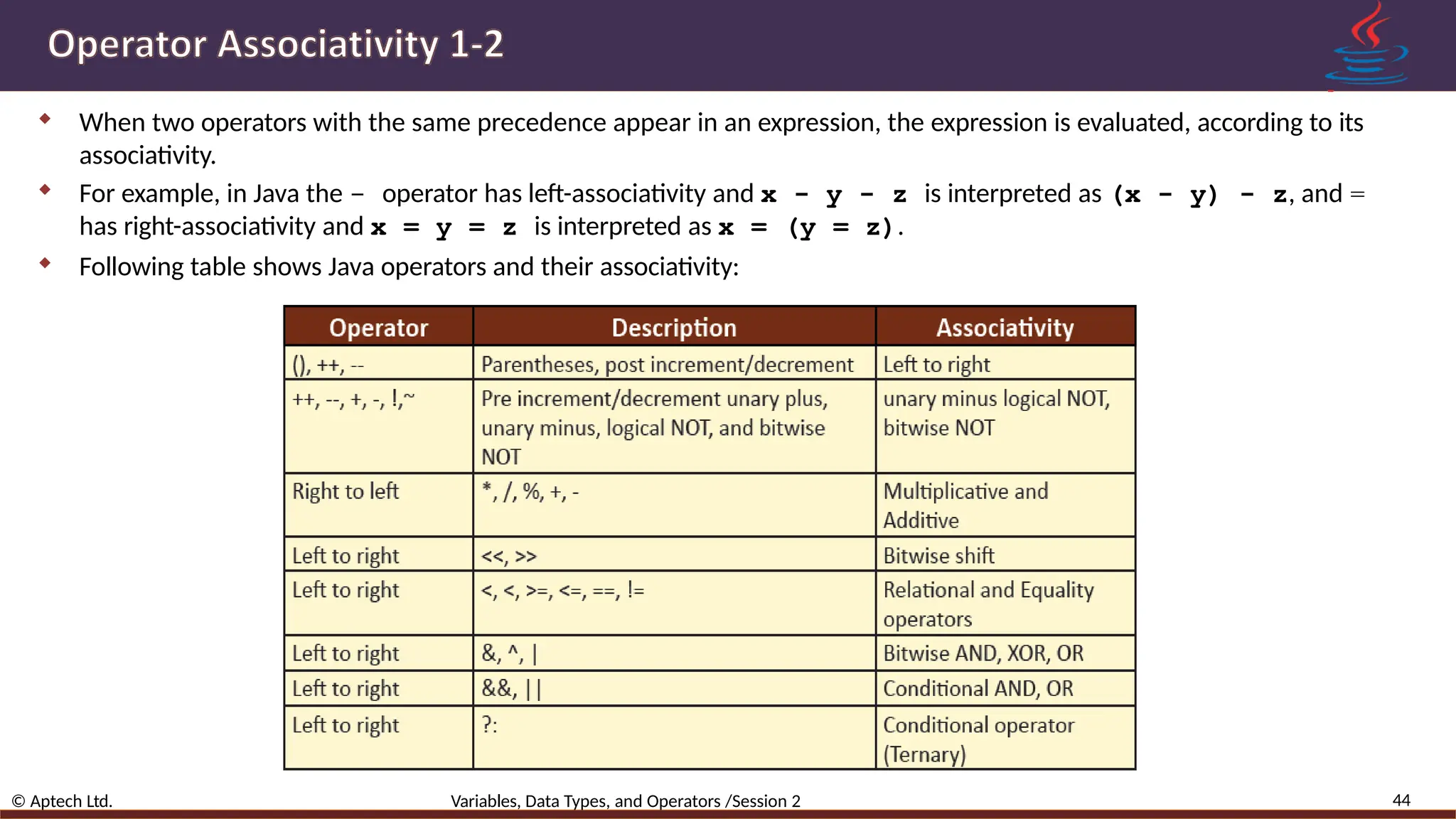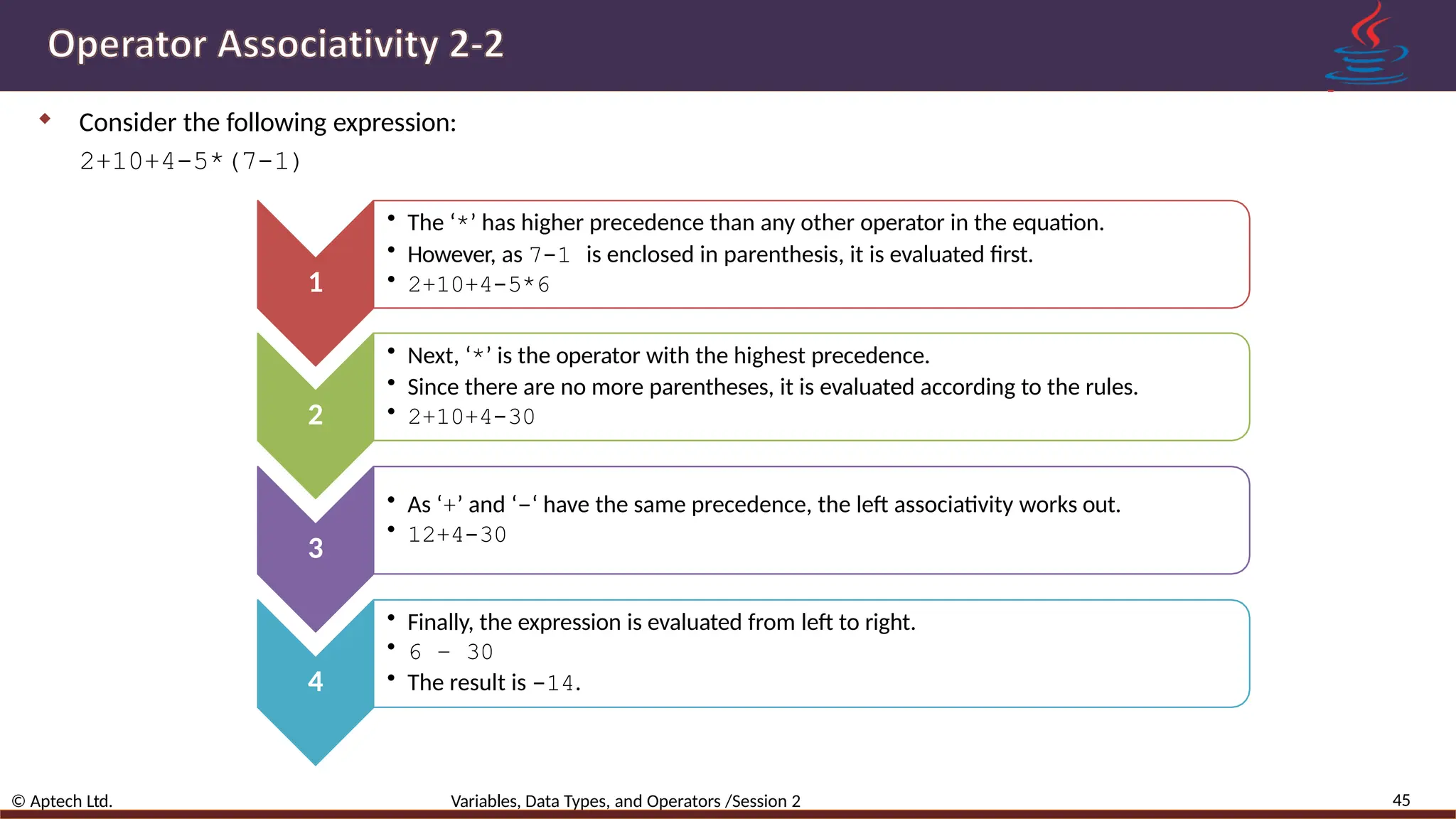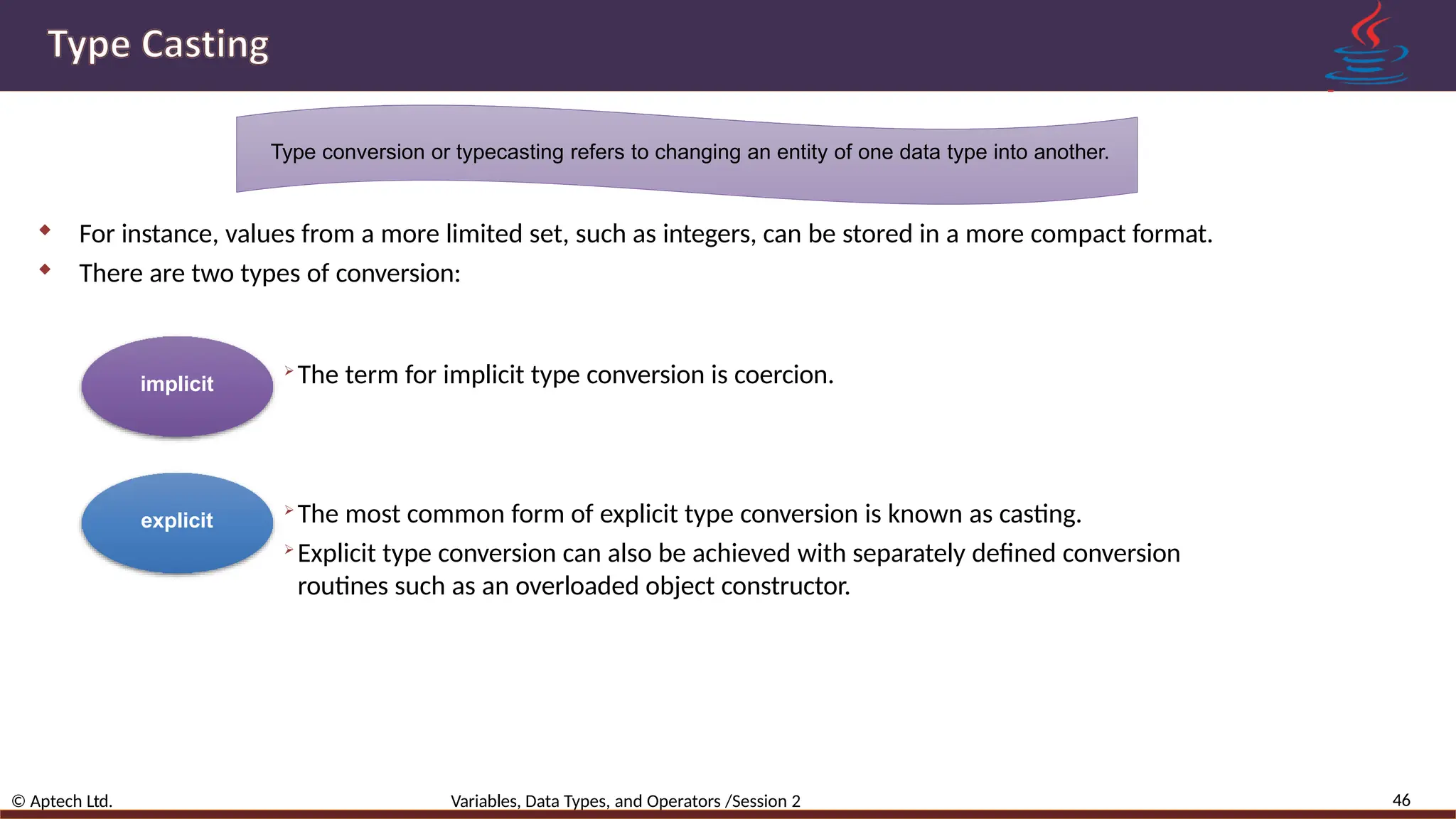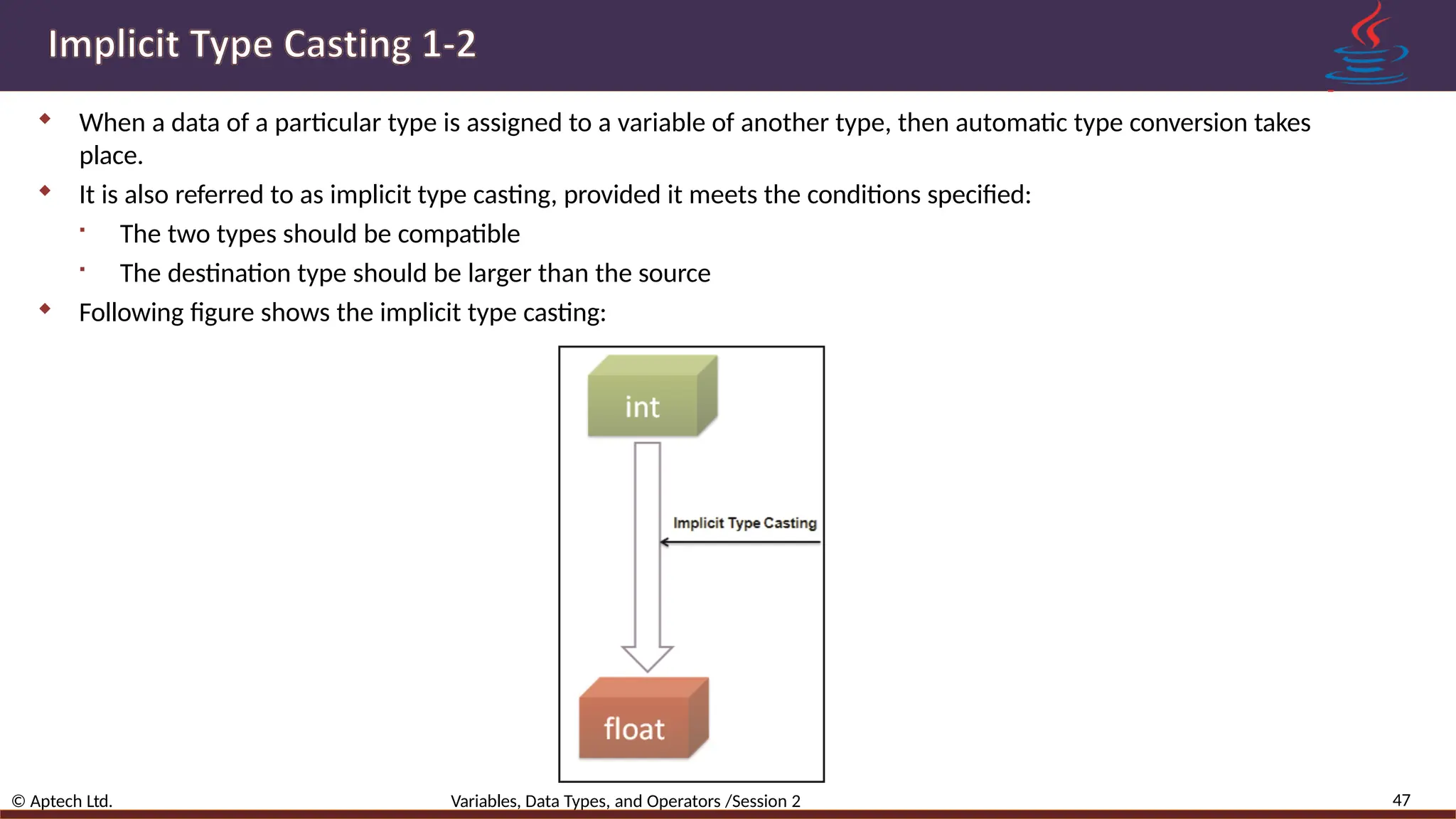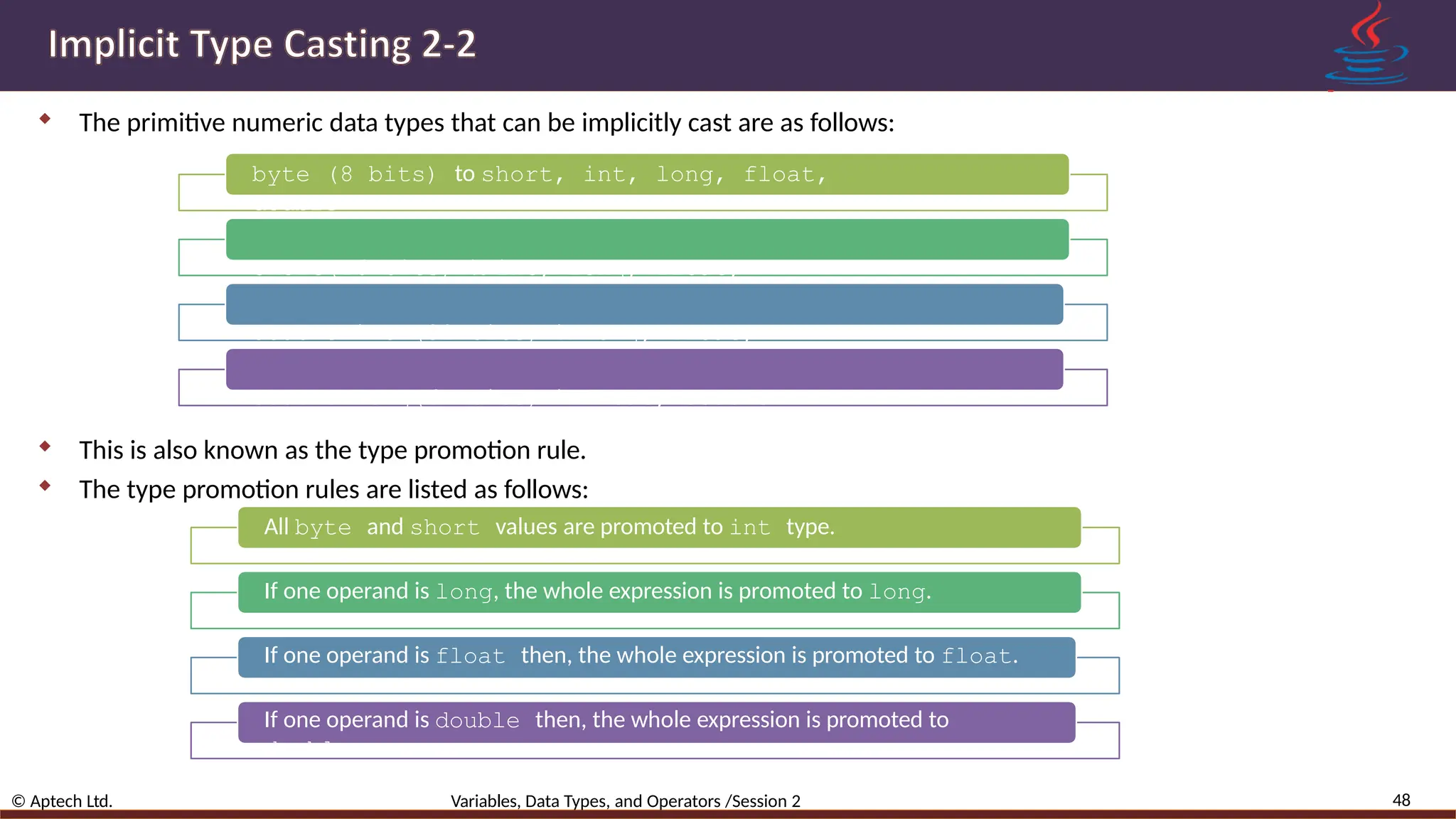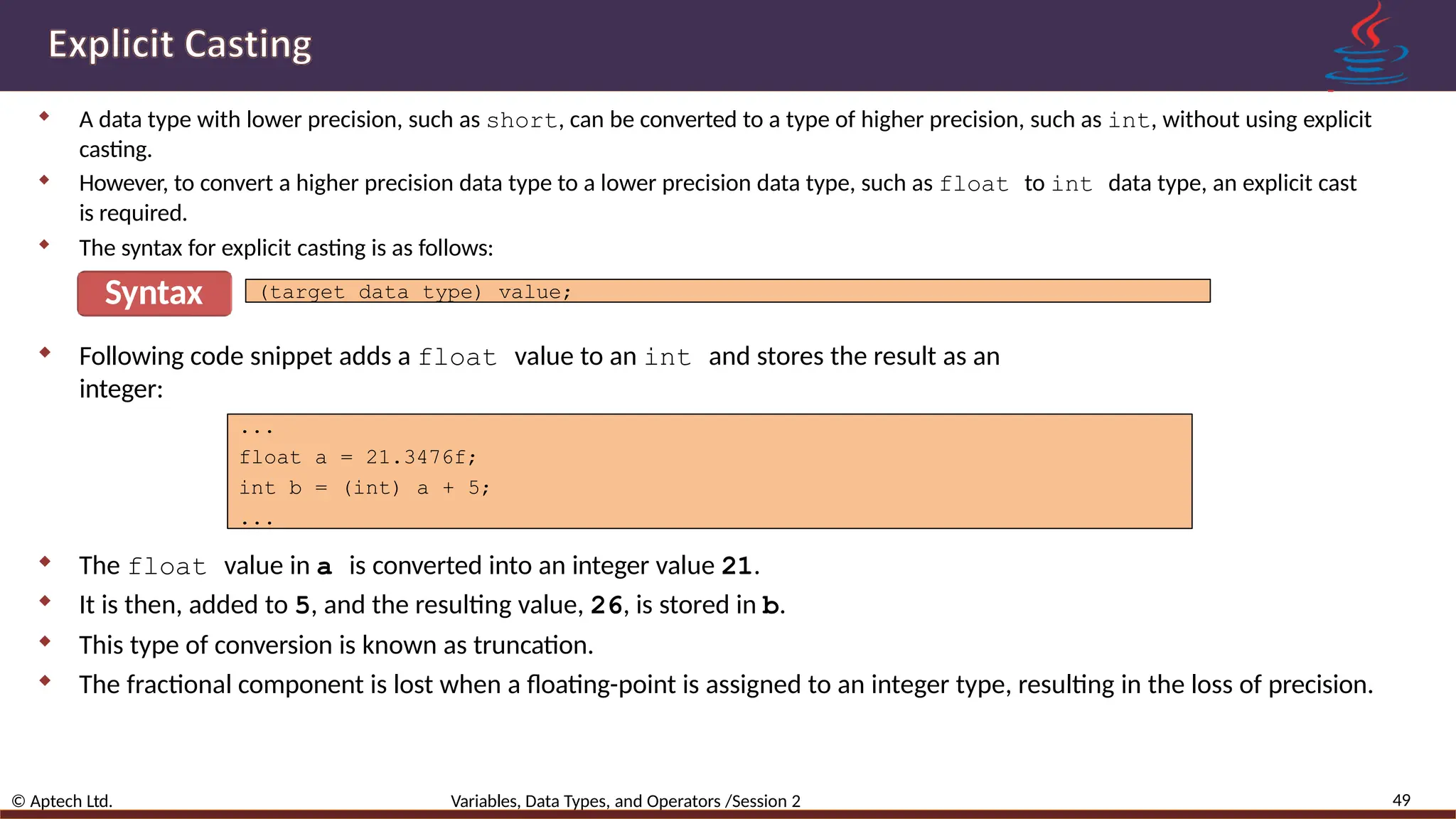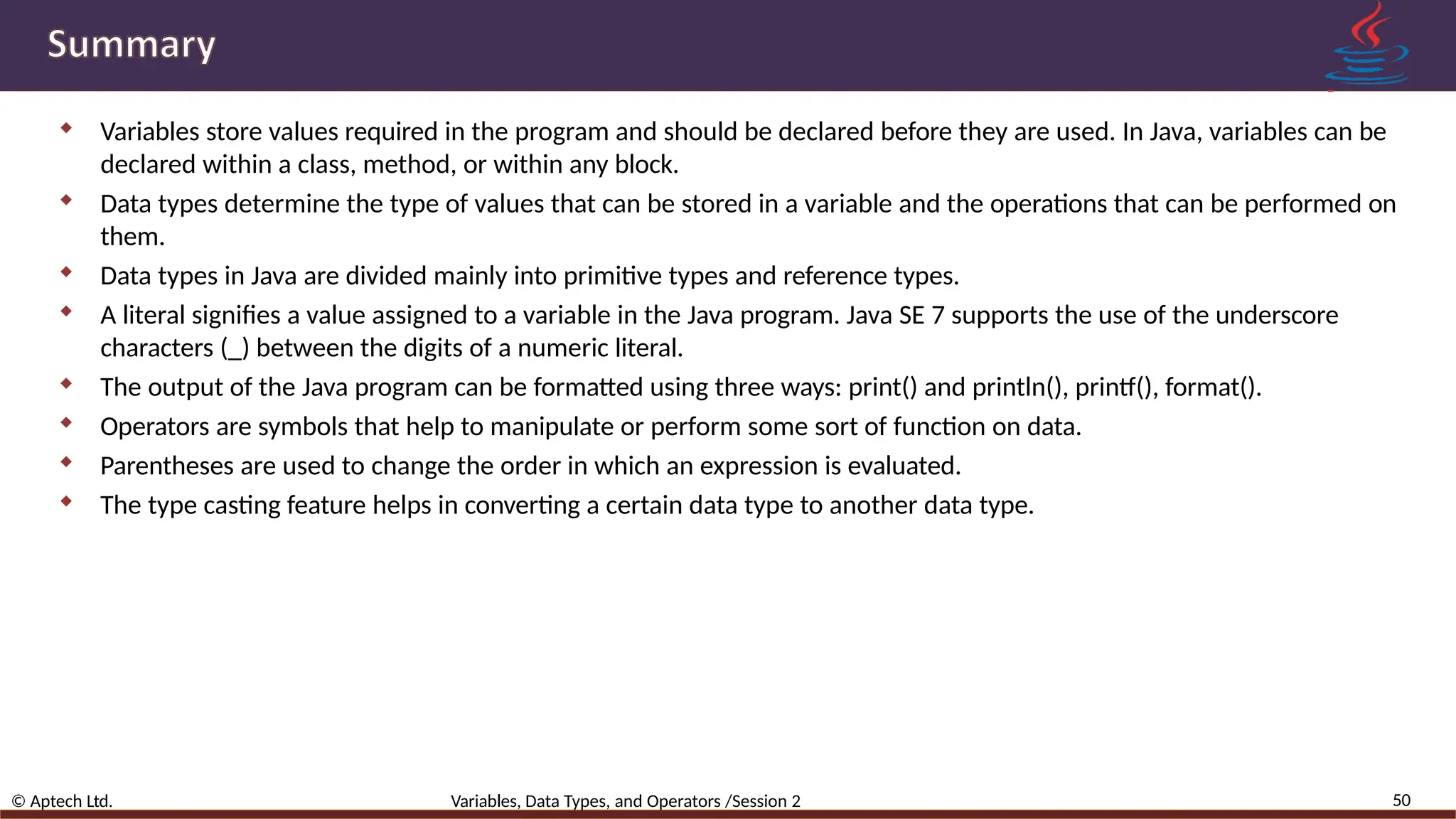Recommended 2.Lesson Plan - Java Variables and Data types.pdf.pdf
Java data types, variables and jvm
Data types ^J variables and arrays in Java.pptx
GUI Programming in JAVA (Using Netbeans) - A Review
Object-Oriented Programming with Java UNIT 1
Dot net programming concept
C language Unit 2 Slides, UPTU C language
In this page, we will learn about the basics of OOPs. Object-Oriented Program...
Java basics and java variables
UNIT – 2 Features of java- (Shilpa R).pptx
Lecture - 3 Variables-data type_operators_oops concept
Data Types, Variables, and Operators
UNIT 2 programming in java_operators.pptx
Fundamental programming structures in java
Topic-5_-Programming-Fundamentals-Part-2.pptx
Programming in Java Unit 1 lesson Notes for Java
Lecture2_MCS4_Evening.pptx
ChapterTwoandThreefnfgncvdjhgjshgjdlahgjlhglj.pptx
TALIS Global Webinar Presentation_Andreas Schleicher.pdf
NOVEL DRUG DELIVERY SYSTEMS (BP 704T ) Unit 4
More Related Content 2.Lesson Plan - Java Variables and Data types.pdf.pdf
Java data types, variables and jvm
Data types ^J variables and arrays in Java.pptx
GUI Programming in JAVA (Using Netbeans) - A Review
Object-Oriented Programming with Java UNIT 1
Similar to Learning Java 2 - Variables, Data Types and Operators Dot net programming concept
C language Unit 2 Slides, UPTU C language
In this page, we will learn about the basics of OOPs. Object-Oriented Program...
Java basics and java variables
UNIT – 2 Features of java- (Shilpa R).pptx
Lecture - 3 Variables-data type_operators_oops concept
Data Types, Variables, and Operators
UNIT 2 programming in java_operators.pptx
Fundamental programming structures in java
Topic-5_-Programming-Fundamentals-Part-2.pptx
Programming in Java Unit 1 lesson Notes for Java
Lecture2_MCS4_Evening.pptx
ChapterTwoandThreefnfgncvdjhgjshgjdlahgjlhglj.pptx
Recently uploaded TALIS Global Webinar Presentation_Andreas Schleicher.pdf
NOVEL DRUG DELIVERY SYSTEMS (BP 704T ) Unit 4
Where has US interest collapsed? Top states and origin countries
LDMMIA Reiki Yoga Greetings Quick Updates
"Aspergillus: Habitat, Structure, Reproduction and Life Cycle"
maxiosocialis quiz for class 7b.ppt.pptx
Alkali and Alkaline Earth Metals - Brief Description.pptx
The crystalline lens of eye/lens/....pdf
Retinal anatomy and physiology/ppt/ .pdf
World Sight day 2025/Love your eyes/.pdf
BPH - SEM - III, STATE OF MATTER - UNIT II - PP - I.pdf
GRADE 8 TLE AFA, WEEK 4 DAY 1-5 MATATAG
Cornea anatomy ppt eyeball cornea. ..pdf
UNIT -1 INTRODUCTION OF PSYCHOLOGY IN GNM.pptx
NSS reopens portal, declares old registrations void ahead of 2025/26 national...
ARAL BASIC KEYSTAGE 2 ^0 3 - SIPAT SURI SA GABAY SA PAGTUTURO AT MGA GAWAING ...
Coal and Types of Coal MCWs and Assertion Reason Questions.pdf
Service Sovereignty in the Age of AI !!!
जनपद स्तरीय नवाचार महोत्सव : आयोजकः जिला शिक्षा एवं प्रशिक्षण संस्थान, बाँदा
B.Com (NEP Syllabus) herbal nutrition Unit 5.pdf
Learning Java 2 - Variables, Data Types and Operators 1. 2. Explain variables and their purpose State the syntax of variable declaration Explain the rules and conventions for naming variables Explain data types Describe primitive and reference data types Describe escape sequence Describe format specifiers Identify and explain different type of operators Explain the concept of casting Explain implicit and explicit conversion 2 © Aptech Ltd. Variables, Data Types, and Operators /Session 2 3. The core of any programming language is the way it stores and manipulates the data. The Java programming language can work with different types of data, such as number, character, boolean, and so on. To work with these types of data, Java programming language supports the concept of variables. A variable is like a container in the memory that holds the data used by the Java program. A variable is associated with a data type that defines the type of data that will be stored in the variable. Java is a strongly-typed language which means that any variable or an object created from a class must belong to its type and should store the same type of data. The compiler checks all expressions variables and parameters to ensure that they are compatible with their data types. 3 © Aptech Ltd. Variables, Data Types, and Operators /Session 2 4. A variable is a location in the computer’s memory which stores the data that is used in a Java program. Following figure depicts a variable that acts as a container and holds the data in it: Variables Are used in a Java program to store data that changes during the execution of the program. Are the basic units of storage in a Java program. Can be declared to store values, such as names, addresses, and salary details. Must be declared before they can be used in the program. A variable declaration begins with data type and is followed by variable name and a semicolon. 4 © Aptech Ltd. Variables, Data Types, and Operators /Session 2 5. The data type can be a primitive data type or a class. The syntax to declare a variable in a Java program is as follows: Syntax 5 © Aptech Ltd. Variables, Data Types, and Operators /Session 2 datatype variableName; where, datatype: Is a valid data type in Java. variableName: Is a valid variable name. Following code snippet demonstrates how to declare variables in a Java program: . . . int rollNumber; char gender; . . . In the code, the statements declare an integer variable named rollNumber, and a character variable called gender. These variables will hold the type of data specified for each of them. 6. Values can be assigned to variables by using the assignment operator (=). There are two ways to assign value to variables. These are as follows: 1. At the time of declaring a variable Following code snippet demonstrates the initialization of variables at the time of declaration: ... int rollNumber = 101; char gender = ‘M’; ... In the code, variable rollNumber is an integer variable, so it has been initialized with a numeric value 101. Similarly, variable gender is a character variable and is initialized with a character ‘M’. Values assigned to the variables are called as literals. Literals are constant values assigned to variables directly in the code without any computation. 6 © Aptech Ltd. Variables, Data Types, and Operators /Session 2 7. After the variable declaration 7 © Aptech Ltd. Variables, Data Types, and Operators /Session 2 Following code snippet demonstrates the initialization of variables after they are declared: int rollNumber; // Variable is declared . . . rollNumber = 101; //variable is initialized . . . Here, the variable rollNumber is declared first and then, it has been initialized with the numeric literal 101. Following code snippet shows the different ways for declaring and initializing variables in Java: // Declares three integer variables x, y, and z int x, y, z; // Declares three integer variables, initializes a and c int a = 5, b, c = 10; // Declares a byte variable num and initializes its value to 20 byte num = 20; // Declares the character variable c with value ‘c’ char c = ‘c’; // Stores value 10 in num1 and num2 int num1 = num2 = 10; // In the code, the declarations, int x, y, z; and int a=5, b, c=10; are examples of comma separated list of variables. The declaration int num1 = num2 = 10; assigns same value to more than one variable at the time of declaration. 8. Java programming language allows you to define different kind of variables that are categorized as follows: Instance variables The state of an object is represented as fields or attributes or instance variables in the class definition. Each object created from a class will have its own copy of instance variables. Static variables These are also known as class variables. Only one copy of static variable is maintained in the memory that is shared by all the objects belonging to that class. These fields are declared using the static keyword. Local variables The variables declared within the blocks or methods of a class are called local variables. A method represents the behavior of an object. The local variables are visible within those methods and are not accessible outside them. A method stores it temporary state in local variables. There is no special keyword available for declaring a local variable, hence, the position of declaration of the variable makes it local. 8 © Aptech Ltd. Variables, Data Types, and Operators /Session 2 9. In Java, variables can be declared within a class, method, or within any block. A scope determines the visibility of variables to other part of the program. Languages such as C/C++ Local Global Java Class Method Class scope Variables declared within the class can be instance variables or static variables. The instance variables are owned by the objects of the class and their existence or scope depends upon the object creation. Static variables are shared between the objects and exists for the lifetime of a class. 9 © Aptech Ltd. Variables, Data Types, and Operators /Session 2 10. The variables defined within the methods of a class are local variables. The lifetime of these variables depends on the execution of methods. This means memory is allocated for the variables when the method is invoked and destroyed when the method returns. After the variables are destroyed, they are no longer in existence. Methods parameters values passed to them during method invocation. The parameter variables are also treated as local variables which means their existence is till the method execution is completed. 10 © Aptech Ltd. Variables, Data Types, and Operators /Session 2 11. When you define a variable in Java, you must inform the compiler what kind of a variable it is. That is, whether it will be expected to store an integer, a character, or some other kind of data. This information tells the compiler how much space to allocate in the memory depending on the data type of a variable. Thus, the data types determine the type of data that can be stored in variables and the operation that can be performed on them. In Java, data types fall under two categories: 11 © Aptech Ltd. Variables, Data Types, and Operators /Session 2 12. The integer data types supported by Java are byte, short, int, and long. These data types can store signed integer values. Signed integers are those integers, which are capable of representing positive as well as negative numbers, such as -40. Java does not provide support for unsigned integers. The floating-point data types supported by Java are float and double. These are also called real numbers, as they represent numbers with fractional precision. For example, calculation of a square root or PI value is represented with a fractional part. 12 © Aptech Ltd. Variables, Data Types, and Operators /Session 2 13. char data type belongs to this group and represents symbols in a character set like letters and numbers. char data type stores 16-bit Unicode character and its value ranges from 0 (‘u0000’) to 65,535 (‘uffff’). Unicode is a 16-bit character set, which contains all the characters commonly used in information processing. It is an attempt to consolidate the alphabets of the world’s various languages into a single and international character set. boolean data type represents true or false values. This data type is used to track true/false conditions. Its size is not defined precisely. Apart from primitive data types, Java programming language also supports strings. A string is a sequence of characters. Java does not provide any primitive data type for storing strings, instead provides a class String to create string variables. The String class is defined within the java.lang package in Java SE API. 13 © Aptech Ltd. Variables, Data Types, and Operators /Session 2 14. Following code snippet demonstrates the use of String class as primitive data type: 14 © Aptech Ltd. Variables, Data Types, and Operators /Session 2 . . . String str = “A String Data”; . . . The statement, String str creates an String object and is not of a primitive data type. When you enclose a string value within double quotes, the Java runtime environment automatically creates an object of String type. Also, once the String variable is created with a value ‘A String Data’, it will remain constant and you cannot change the value of the variable within the program. However, initializing string variable with new value creates a new String object. This behavior of strings makes them as immutable objects. 15. Following code snippet demonstrates the use of different data types in Java: public class EmployeeData { /** * @param args the command line arguments */ public static void main(String[] args) { 15 © Aptech Ltd. Variables, Data Types, and Operators /Session 2 // Declares a variable of type integer int empNumber; //Declares a variable of type decimal float salary; // Declare and initialize a decimal variable double shareBalance = 456790.897; // Declare a variable of type character char gender = ‘M’; // Declare and initialize a variable of type boolean boolean ownVehicle = false; // Variables, empNumber and salary are initialized empNumber = 101; salary = 6789.50f; // Prints the value of the variables on the console System.out.println(“Employee Number: “ + empNumber); System.out.println(“Salary: “ + salary); System.out.println(“Gender: “ + gender); System.out.println(“Share Balance: “ + shareBalance); System.out.println(“Owns vehicle: “ + ownVehicle); } } 16. In Java, objects and arrays are referred to as reference variables. Reference data type is an address of an object or an array created in memory. Following table lists and describes the three reference data types: 16 © Aptech Ltd. Variables, Data Types, and Operators /Session 2 Data Type Description Array It is a collection of several items of the same data type. For example, names of students in a class can be stored in an array. Class It is encapsulation of instance variables and instance methods. Interface It is a type of class in Java used to implement inheritance. 17. A literal represents a fixed value assigned to a variable. It is represented directly in the code and does not require computation. Following figure shows some literals for primitive data types: A literal is used wherever a value of its type is allowed. However, there are several different types of literals as follows: Integer Literals Integer literals are used to represent an int value, which in Java is a 32-bit integer value. Integers literals can be expressed as: Decimal values have a base of 10 and consist of numbers from 0 through 9. For example, int decNum = 56;. Hexadecimal values have a base of 16 and consist of numbers 0 through 9 and letters A through F. For example, int hexNum = 0X1c;. 17 © Aptech Ltd. Variables, Data Types, and Operators /Session 2 18. Binary values have a base of 2 and consist of numbers 0 and 1. Java SE 7 supports binary literals. For example, int binNum = 0b0010;. An integer literal can also be assigned to other integer types, such as byte or long. When a literal value is assigned to a byte or short variable, no error is generated, if the literal value is within the range of the target type. Integer numbers can be represented with an optional uppercase character (‘L’) or lowercase character (‘l’) at the end. This will inform the computer to treat that number as a long (64-bit) integer. Floating-point Literals Floating-point literals represent decimal values with a fractional component. Floating-point literals have several parts. Whole number component, for example 0, 1, 2,....., 9. Decimal point, for example 4.90, 3.141, and so on. 18 © Aptech Ltd. Variables, Data Types, and Operators /Session 2 19. Exponent is indicated by an E or e followed by a decimal number, which can be positive or negative. For example, e+208, 7.436E6, 23763E-05, and so on. Type suffix D, d, F, or f. Floating-point literals in Java default to double precision. A float literal is represented by F or f appended to the value, and a double literal is represented by D or d. Boolean Literals Boolean literals are simple and have only two logical values - true and false. These values do not convert into any numerical representation. A true boolean literal in Java is not equal to one, nor does the false literal equals to zero. They can only be assigned to boolean variables or used in expressions with boolean operators. 19 © Aptech Ltd. Variables, Data Types, and Operators /Session 2 20. Character Literals Character literals are enclosed in single quotes. All the visible ASCII characters can be directly enclosed within quotes, such as ‘g’, ‘$’, and ‘z’. Single characters that cannot be enclosed within single quotes are used with escape sequence. Null Literals When an object is created, a certain amount of memory is allocated for that object. The starting address of the allocated memory is stored in an object variable, that is, a reference variable. However, at times, it is not desirable for the reference variable to refer that object. In such a case, the reference variable is assigned the literal value null. For example, Car toyota = null;. String Literals String literals consist of sequence of characters enclosed in double quotes. For example, “Welcome to Java”, “HellonWorld”. 20 © Aptech Ltd. Variables, Data Types, and Operators /Session 2 21. Java SE 7 allows you to add underscore characters (_) between the digits of a numeric literal. The underscore character can be used only between the digits. In integral literals, underscore characters can be provided for telephone numbers, identification numbers, or part numbers, and so on. Similarly, for floating-point literals, underscores are used between large decimal values. Restrictions for using underscores in numeric literals are as follows: A number cannot begin or end with an underscore. In the floating-point literal, underscore cannot be placed adjacent to a decimal point. Underscore cannot be placed before a suffix, L or F. Underscore cannot be placed before or after the binary or hexadecimal identifiers, such as b or x. 21 © Aptech Ltd. Variables, Data Types, and Operators /Session 2 22. An escape sequence is a special sequence of characters that is used to represent characters, which cannot be entered directly into a string. For example, to include tab spaces or a new line character in a line or to include characters which otherwise have a different notation in a Java program ( or “), escape sequences are used. An escape sequence begins with a backslash character (), which indicates that the character (s) that follows should be treated in a special way. The output displayed by Java can be formatted with the help of escape sequence characters. Following table lists escape sequence characters in Java: 22 © Aptech Ltd. Variables, Data Types, and Operators /Session 2 23. Following code snippet demonstrates the use of escape sequence characters: 23 © Aptech Ltd. Variables, Data Types, and Operators /Session 2 public class EscapeSequence { /* * @param args the command line arguments */ public static void main(String[] args) { // Uses tab and new line escape sequences System.out.println(“Java t Programming n Language”); // Prints Tom “Dick” Harry string System.out.println(“Tom ”Dick” Harry”); } } To represent a Unicode character, u escape sequence can be used in a Java program. A Unicode character can be represented using hexadecimal or octal sequences. public class UnicodeSequence { /** * @param args the command line arguments */ public static void main(String[] args) { // Prints ‘Hello’ using hexadecimal escape sequence characters System.out.println(“u0048u0065u006Cu006Cu006F” + “!n”); // Prints ‘Blake’ using octal escape sequence character for ‘a’ System.out.println(“Bl141ke”2007” “); } } Following code snippet demonstrates the Unicode characters in a Java program: 24. Constants in Java are fixed values assigned to identifiers that are not modified throughout the execution of the code. In Java, the declaration of constant variables is prefixed with the final keyword. The syntax to initialize a constant variable is as follows: Syntax where, 24 © Aptech Ltd. Variables, Data Types, and Operators /Session 2 final data-type variable-name = value; final: Is a keyword and denotes that the variable is declared as a constant. Following code snippet demonstrates code that declares constant variables: public class AreaOfCircle { /** * @param args the command line arguments */ public static void main(String[] args) { // Declares constant variable final double PI = 3.14159; double radius = 5.87; double area; // Calculates the value for the area variable area = PI * radius * radius; System.out.println(“Area of the circle is: “ + area); } } 25. Java SE 5.0 introduced enumerations. An enumeration is defined as a list that contains constants. Unlike C++, where enumeration was a list of named integer constants, in Java, enumeration is a class type. This means it can contain instance variables, methods, and constructors. The enumeration is created using the enum keyword. The syntax for declaring a method is as follows: Syntax 25 © Aptech Ltd. Variables, Data Types, and Operators /Session 2 enum enum-name { constant1, constant2, . . . , constantN } 26. Though, enumeration is a class in Java, you do not use new operator to instantiate it. Instead, declare a variable of type enumeration to use it in the Java program. This is similar to using primitive data types. The enumeration is mostly used with decision-making constructs, such as switch-case statement. 26 © Aptech Ltd. Variables, Data Types, and Operators /Session 2 public class EnumDirection { /** * Declares an enumeration */ enum Direction { East, West, North, South } /** * @param args the command line arguments */ public static void main(String[] args) { // Declares a variable of type Direction Direction direction; // Instantiate the enum Direction direction = Direction.East; // Prints the value of enum System.out.println(“Value: “ + direction); } } Following code snippet demonstrates the declaration of enumeration in a Java program: 27. Whenever an output is to be displayed on the screen, it needs to be formatted. Formatting can be done using three ways that are as follows: print() and println() printf() format() 27 © Aptech Ltd. Variables, Data Types, and Operators /Session 2 These methods behave in a similar manner. The format() method uses the java.util.Formatter class to do the formatting work. 28. These methods convert all the data to strings and display it as a single value. The method uses appropriate toString() method for conversion of the values. These methods can also be used to print mixture combination of strings and numeric values as strings on the standard output. public class DisplaySum { /** * @param args the command line arguments */ public static void main(String[] args) { int num1 = 5; int num2 = 10; int sum = num1 + num2; System.out.print(“The sum of “); System.out.print(num1); System.out.print(“ and “); System.out.print(num2); System.out.print(“ is “); System.out.print(sum); System.out.println(“.”); int num3 = 2; sum = num1 + num2 + num3; System.out.println(“The sum of “ + num1 + “, “ + num2 + “ and “ + num3 + “ is “ + sum + “.”); } } 28 © Aptech Ltd. Variables, Data Types, and Operators /Session 2 Following code snippet demonstrates use of print() and println() methods: 29. The printf() method introduced in J2SE 5.0 can be used to format the numerical output to the console. 29 © Aptech Ltd. Variables, Data Types, and Operators /Session 2 Following code snippet demonstrates the use of printf() methods to format the output: public class FormatSpecifier { /** * @param args the command line arguments */ public static void main(String[] args) { int i = 55 / 22; // Decimal integer System.out.printf(“55/22 = %d %n”, i); // Pad with zeros double q = 1.0 / 2.0; System.out.printf(“1.0/2 .0 = %09.3f %n”, q); // Scientific notation q = 5000.0 / 3.0; System.out.printf(“5000/3 .0 = %7.2e %n”, q); // Negative infinity q = -10.0 / 0.0; System.out.printf(“- 10.0/0.0 = %7.2e %n”, q); // Multiple arguments, PI value, E–base of natural logarithm System.out.printf(“pi 30. This method formats multiple arguments based on a format string. The format string consists of the normal string literal information associated with format specifiers and an argument list. The syntax of a format specifier is as follows: Syntax %[arg_index$] [flags] [width] [.precision] conversion character where, arg_index: Is an integer followed by a $ symbol. The integer indicates that the argument should be printed in the mentioned position. flags: Is a set of characters that format the output result. There are different flags available in Java. 30 © Aptech Ltd. Variables, Data Types, and Operators /Session 2 31. The values within ‘[]’ are optional. The only required elements of format specifier are the % and a conversion character. Following code snippet demonstrates the format() method: 31 © Aptech Ltd. Variables, Data Types, and Operators /Session 2 public class VariableScope { /** * @param args the command line arguments */ public static void main(String[] args) { int num = 2; double result = num * num; System.out.format(“The square root of %d is %f.%n”, num, result); } } 32. The Scanner class allows the user to read or accept values of various data types from the keyboard. It breaks the input into tokens and translates individual tokens depending on their data type. To use the Scanner class, pass the InputStream object to the constructor as follows: Scanner input = new Scanner(System.in); Here, input is an object of Scanner class and System.in is an input stream object. Following table lists different methods of the Scanner class that can be used to accept numerical values from the user: 32 © Aptech Ltd. Variables, Data Types, and Operators /Session 2 33. Following code snippet demonstrates the Scanner class methods and how they can be used to accept values from the user: 33 © Aptech Ltd. Variables, Data Types, and Operators /Session 2 public class FormattedInput { /** * @param args the command line arguments */ public static void main(String[] args) { // Creates an object and passes the inputstream object Scanner s = new Scanner(System.in); System.out.println(“Enter a number:”); // Accepts integer value from the user int intValue = s.nextInt(); System.out.println(“Enter a decimal number:”); // Accepts integer value from the user float floatValue = s.nextFloat(); System.out.println(“Enter a String value”); // Accepts String value from the user String strValue = s.next(); System.out.println(“Values entered are: “); System.out.println(intValue + “ “ + floatValue + “ “ + strValue); } } 34. Here, • Is called the Operator and the operation performed is addition. + • The two variables X and Y, on which addition is performed, are called as Operands. X and Y • A combination of both the operator and the operands, is known as an Expression. Z = X + Y Java provides several categories of operators and they are as follows: Operators are set of symbols used to indicate the kind of operation to be performed on data. Consider the expression: Z = X + Y; 34 © Aptech Ltd. Variables, Data Types, and Operators /Session 2 35. The basic assignment operator is a single equal to sign, ‘=’. This operator is used to assign the value on its right to the operand on its left. Assigning values to more than one variable can be done at a time. In other words, it allows you to create a chain of assignments. 35 © Aptech Ltd. Variables, Data Types, and Operators /Session 2 Consider the following statements: int balance = 3456; char gender = ‘M’; The value 3456 and ‘M’ are assigned to the variables, balance and gender. In addition to the basic assignment operator, there are combined operators that allow you to use a value in an expression, and then, set its value to the result of that expression. X = 3; X += 5; The second statement stores the value 8, the meaning of the statement is that X = X + 5. ... x = 10; // Assigns the value 10 to variable x x += 5; // Increments the value of x by 5 x -= 5; // Decrements the value of x by 5 x *= 5; // Multiplies the value of x by 5 x /= 2; // Divides the value of x by 2 x %= 2; // Divides the value of x by 2 and the remainder is returned Following code snippet demonstrates use of assignment operators: 36. Arithmetic operators manipulate numeric data and perform common arithmetic operations on the data. Operands of the arithmetic operators must be of numeric type. Boolean operands cannot be used, but character operands are allowed. The operators mentioned here are binary in nature that is, these operate on two operands, such as X+Y. Here, + is a binary operator operating on X and Y. Following table lists the arithmetic operators: Following code snippet demonstrates the use of arithmetic operators: ... 36 © Aptech Ltd. Variables, Data Types, and Operators /Session 2 x = 2 + 3; // Returns 5 y = 8 – 5; // Returns 3 x = 5 * 2; // Returns 10 x = 5/2; // Returns 2 y = 10 % 3; // Returns 1 ... 37. Unary operators require only one operand. They increment/decrement the value of a variable by 1, negate an expression, or invert the value of a boolean variable. Following table lists the unary operators: The prefix version (++variable) will increment the value before evaluating. The postfix version (variable++) will first evaluate and then, increment the original value. Following code snippet demonstrates the use of unary operators: ... int i = 5; int j = i++; // i=6, j=5 int k = ++i; //i=6,k=6 i = - i ; //now i is -6 boolean result = false; //result is false result = !result; //now result is true … 37 © Aptech Ltd. Variables, Data Types, and Operators /Session 2 38. The conditional operators test the relationship between two operands. An expression involving conditional operators always evaluates to a boolean value (that is, either true or false). 38 © Aptech Ltd. Variables, Data Types, and Operators /Session 2 Following code snippet demonstrates use of conditional operators: public class TestConditionalOperators { /** * @param args the command line arguments */ public static void main(String[] args) { int value1 = 10; int value2 = 20; // Use of conditional operators System.out.print(“value1 == value2: “); System.out.println(value1 == value2); System.out.print(“value1 != value2: “); System.out.println(value1 != value2); System.out.print(“value1 > value 2: “); System.out.println(value1 > value2); System.out.print(“value1 < value2: “); System.out.println(value1 < value2); System.out.print(“value1 <= value2: “); System.out.println(value1 <= value2); } } 39. Logical operators (&& and ||) work on two boolean expressions. These operators exhibit short-circuit behavior, which means that the second operand is evaluated only if required. Following code snippet demonstrates the use of logical operators: 39 © Aptech Ltd. Variables, Data Types, and Operators /Session 2 public class TestLogicalOperators { /** * @param args the command line arguments */ public static void main(String[] args) { int first = 10; int second = 20; // Use of logical operator System.out.println((first == 30) && (second == 20)); System.out.println((first == 30) || (second == 20)); } } 40. Bitwise operators work on binary representations of data. These operators are used to change individual bits in an operand. Following code snippet demonstrates the use of bitwise operators: 40 © Aptech Ltd. Variables, Data Types, and Operators /Session 2 public class TestBitwiseOperators { /** * @param args the command line arguments */ public static void main(String[] args) { int x = 23; int y = 12; //23 = 10111 , 12 = 01100 System.out.print(“x & y: “); System.out.println(x & y); // Returns 4 , i.e, 4 = 00100 System.out.print(“x | y: “); System.out.println(x | y); // Returns 31, i.e 31 = 11111 System.out.print(“x ^ y: “); System.out.println(x ^ y); // Returns 27, i.e 31 = 11011 int a = 43; int b = 1; System.out.print(“a >> b: “); System.out.println(a >> b); // returns 21 , i.e, 21 = 0010101 System.out.print(“a << b: “); System.out.println(a << b); //returns 86 , i.e, 86 = 1010110 41. The ternary operator (?:) is a shorthand operator for an if-else statement. It makes your code compact and more readable. The syntax to use the ternary operator is as follows: Syntax 41 © Aptech Ltd. Variables, Data Types, and Operators /Session 2 expression1 ? expression2 : expression3 Following code snippet demonstrates the use of ternary operator: public class VariableScope { /** * @param args the command line arguments */ public static void main(String[] args) { int value1 = 10; int value2 = 20; int result; boolean someCondition = true; result = someCondition ? value1 : value2; System.out.println(result); } } 42. Expressions that are written generally consist of several operators. The rules of precedence decide the order in which each operator is evaluated in any given expression. Following table lists the order of precedence of operators from highest to lowest in which operators are evaluated in Java: Parentheses are used to change the order in which an expression is evaluated. Any part of an expression enclosed in parentheses is evaluated first. For example, consider the following expression: 2*3+4/2 > 3 && 3<5 || 10<9 42 © Aptech Ltd. Variables, Data Types, and Operators /Session 2 43. The evaluation of the expression based on its operators precedence is as follows: 1 • (2*3+4/2) > 3 && 3<5 || 10<9 • First the arithmetic operators are evaluated. 2 • ((2*3)+(4/2)) > 3 && 3<5 || 10<9 • Division and Multiplication are evaluated before addition and subtraction. 3 • (6+2) >3 && 3<5 || 10<9 4 • (8>3) && [3<5] || [10<9] • Next to be evaluated are the relational operators all of which have the same precedence. 5 • These are therefore evaluated from left to right. • (True && True) || False 6 • The last to be evaluated are the logical operators. && takes precedence over ||. • True || False 7 • True 43 © Aptech Ltd. Variables, Data Types, and Operators /Session 2 44. When two operators with the same precedence appear in an expression, the expression is evaluated, according to its associativity. For example, in Java the - operator has left-associativity and x - y - z is interpreted as (x - y) - z, and = has right-associativity and x = y = z is interpreted as x = (y = z). Following table shows Java operators and their associativity: 44 © Aptech Ltd. Variables, Data Types, and Operators /Session 2 45. Consider the following expression: 2+10+4-5*(7-1) 1 • The ‘*’ has higher precedence than any other operator in the equation. • However, as 7-1 is enclosed in parenthesis, it is evaluated first. • 2+10+4-5*6 2 • Next, ‘*’ is the operator with the highest precedence. • Since there are no more parentheses, it is evaluated according to the rules. • 2+10+4-30 3 • As ‘+’ and ‘-‘ have the same precedence, the left associativity works out. • 12+4-30 4 • Finally, the expression is evaluated from left to right. • 6 – 30 • The result is -14. 45 © Aptech Ltd. Variables, Data Types, and Operators /Session 2 46. Type conversion or typecasting refers to changing an entity of one data type into another. For instance, values from a more limited set, such as integers, can be stored in a more compact format. There are two types of conversion: implicit explicit 46 © Aptech Ltd. Variables, Data Types, and Operators /Session 2 The term for implicit type conversion is coercion. The most common form of explicit type conversion is known as casting. Explicit type conversion can also be achieved with separately defined conversion routines such as an overloaded object constructor. 47. When a data of a particular type is assigned to a variable of another type, then automatic type conversion takes place. It is also referred to as implicit type casting, provided it meets the conditions specified: The two types should be compatible The destination type should be larger than the source Following figure shows the implicit type casting: 47 © Aptech Ltd. Variables, Data Types, and Operators /Session 2 48. The primitive numeric data types that can be implicitly cast are as follows: byte (8 bits) to short, int, long, float, double short(16 bits) to int, long, float, double int (32 bits) to long, float, double long(64 bits) to float, double This is also known as the type promotion rule. The type promotion rules are listed as follows: All byte and short values are promoted to int type. If one operand is long, the whole expression is promoted to long. If one operand is float then, the whole expression is promoted to float. If one operand is double then, the whole expression is promoted to double. 48 © Aptech Ltd. Variables, Data Types, and Operators /Session 2 49. A data type with lower precision, such as short, can be converted to a type of higher precision, such as int, without using explicit casting. However, to convert a higher precision data type to a lower precision data type, such as float to int data type, an explicit cast is required. The syntax for explicit casting is as follows: Syntax 49 © Aptech Ltd. Variables, Data Types, and Operators /Session 2 (target data type) value; Following code snippet adds a float value to an int and stores the result as an integer: ... float a = 21.3476f; int b = (int) a + 5; ... The float value in a is converted into an integer value 21. It is then, added to 5, and the resulting value, 26, is stored in b. This type of conversion is known as truncation. The fractional component is lost when a floating-point is assigned to an integer type, resulting in the loss of precision. 50. Variables store values required in the program and should be declared before they are used. In Java, variables can be declared within a class, method, or within any block. Data types determine the type of values that can be stored in a variable and the operations that can be performed on them. Data types in Java are divided mainly into primitive types and reference types. A literal signifies a value assigned to a variable in the Java program. Java SE 7 supports the use of the underscore characters (_) between the digits of a numeric literal. The output of the Java program can be formatted using three ways: print() and println(), printf(), format(). Operators are symbols that help to manipulate or perform some sort of function on data. Parentheses are used to change the order in which an expression is evaluated. The type casting feature helps in converting a certain data type to another data type. 50 © Aptech Ltd. Variables, Data Types, and Operators /Session 2 Editor's Notes #3 Cốt lõi của bất kỳ ngôn ngữ lập trình nào là cách nó lưu trữ và xử lý dữ liệu. Ngôn ngữ lập trình Java có thể làm việc với nhiều loại dữ liệu khác nhau, chẳng hạn như số, ký tự, boolean, v.v. Để làm việc với các loại dữ liệu này, ngôn ngữ lập trình Java hỗ trợ khái niệm biến. Biến giống như một vùng chứa trong bộ nhớ chứa dữ liệu mà chương trình Java sử dụng. Biến được liên kết với một kiểu dữ liệu xác định kiểu dữ liệu sẽ được lưu trữ trong biến. Java là ngôn ngữ có kiểu mạnh, nghĩa là bất kỳ biến hoặc đối tượng nào được tạo từ một lớp phải thuộc về kiểu của nó và phải lưu trữ cùng một kiểu dữ liệu. Trình biên dịch kiểm tra tất cả các biến biểu thức và tham số để đảm bảo rằng chúng tương thích với kiểu dữ liệu của chúng. #4 Biến Được sử dụng trong chương trình Java để lưu trữ dữ liệu thay đổi trong quá trình thực thi chương trình. Là đơn vị lưu trữ cơ bản trong chương trình Java. Có thể được khai báo để lưu trữ các giá trị, chẳng hạn như tên, địa chỉ và thông tin chi tiết về lương. Phải được khai báo trước khi có thể sử dụng trong chương trình. Khai báo biến bắt đầu bằng kiểu dữ liệu và theo sau là tên biến và dấu chấm phẩy. #17 Một giá trị cố định được gán cho một biến. Nó được biểu diễn trực tiếp trong mã và không yêu cầu tính toán. Hình sau đây cho thấy một số giá trị cố định cho các kiểu dữ liệu nguyên thủy:
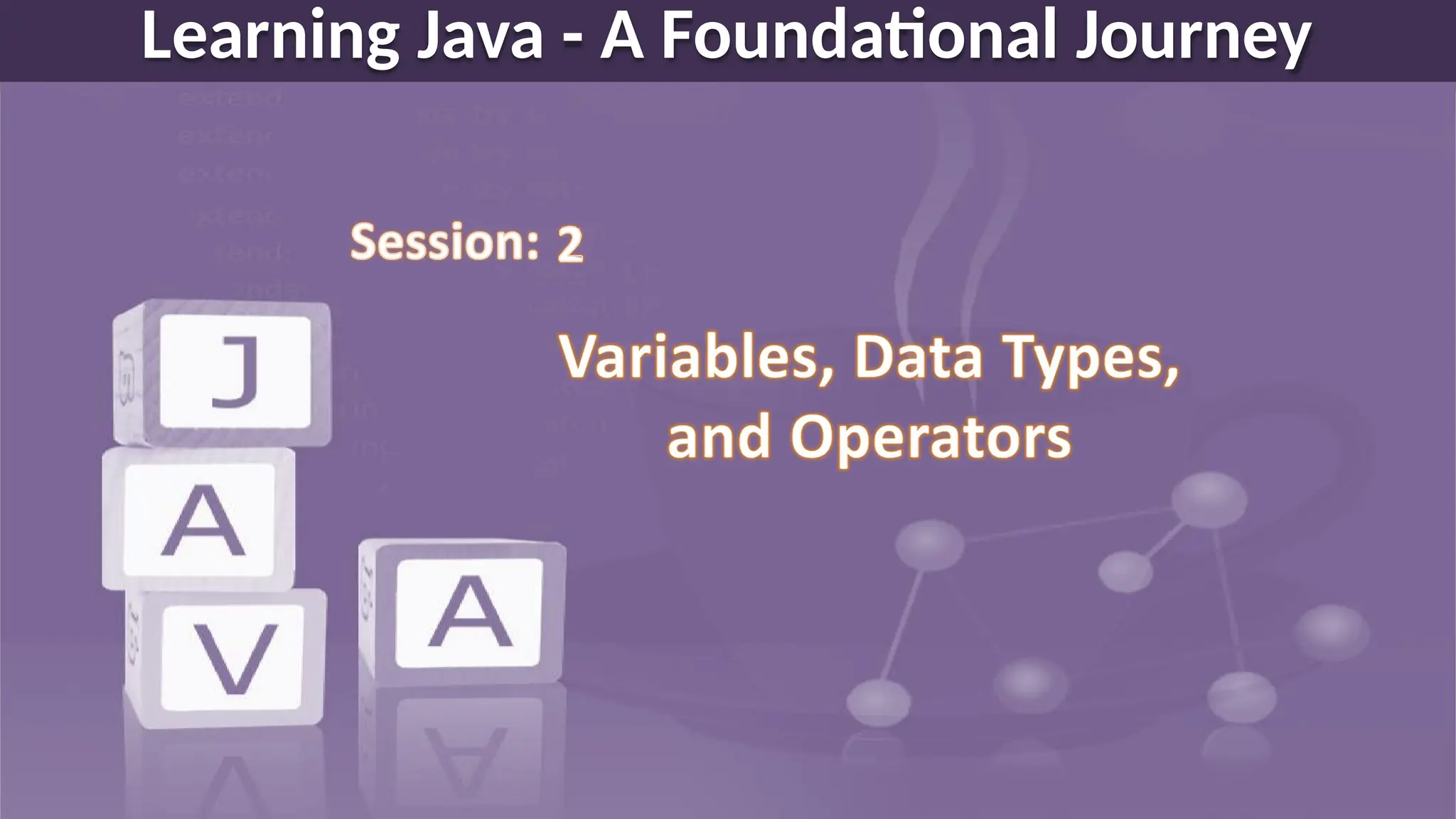
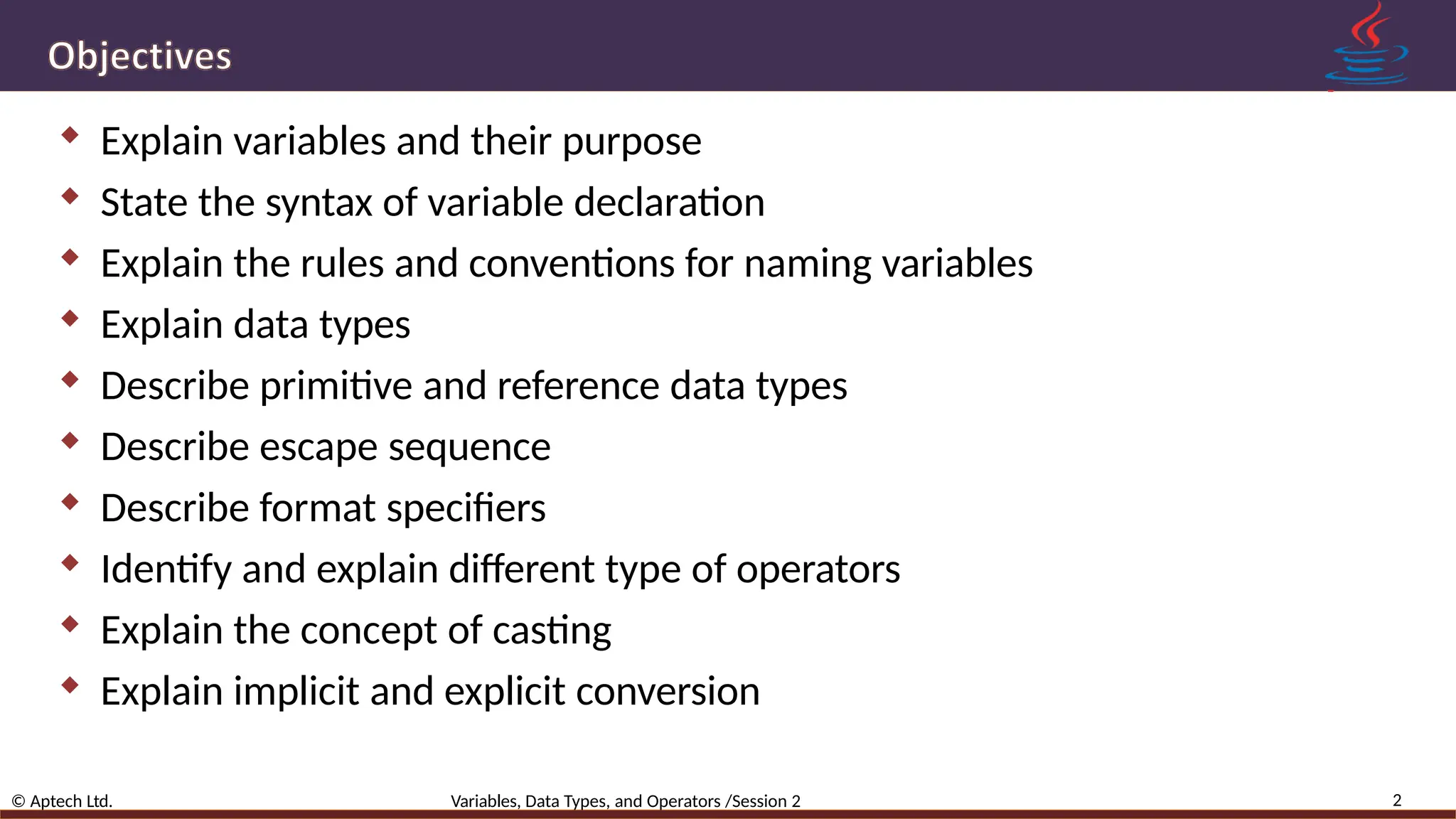
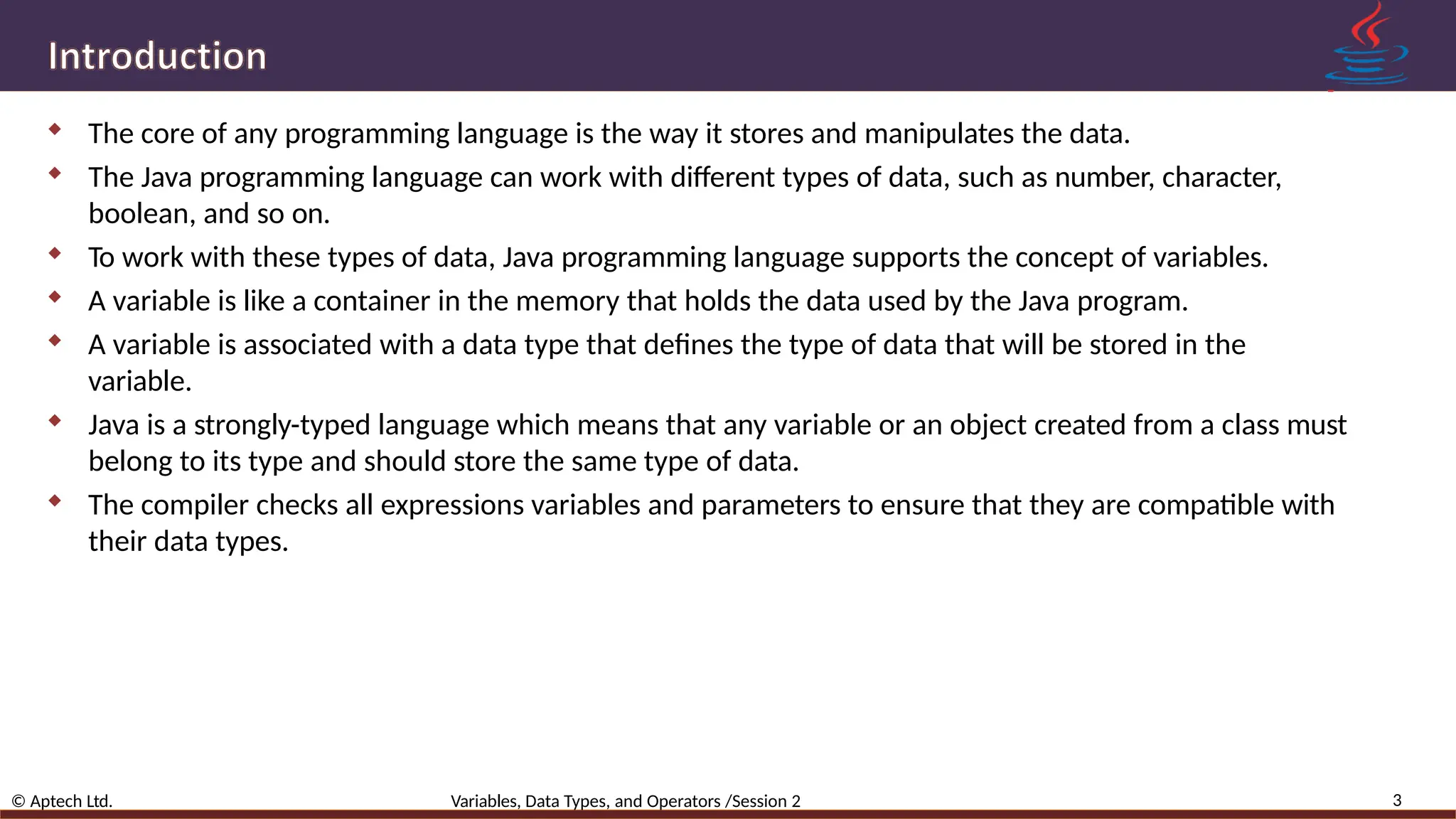
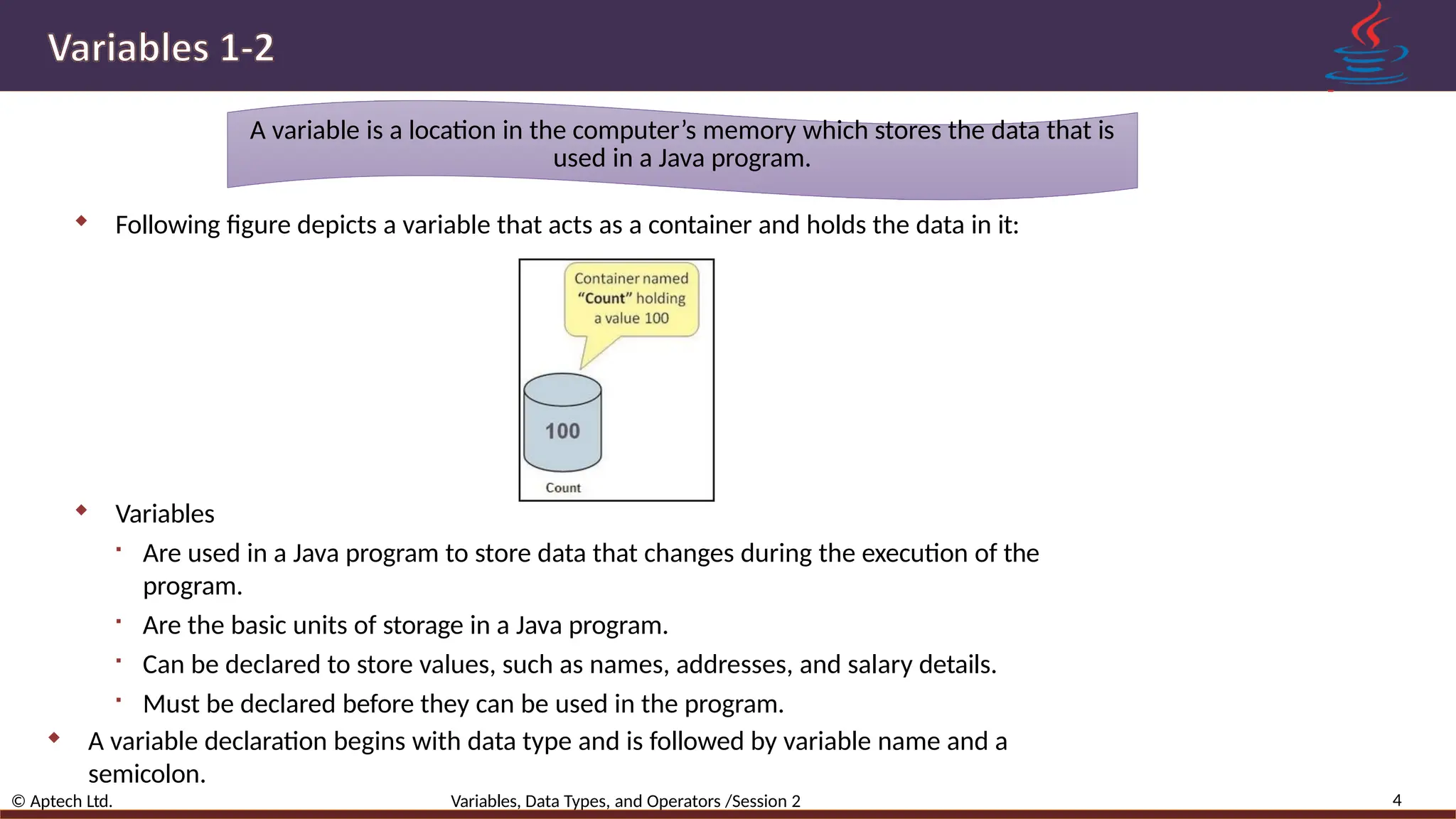
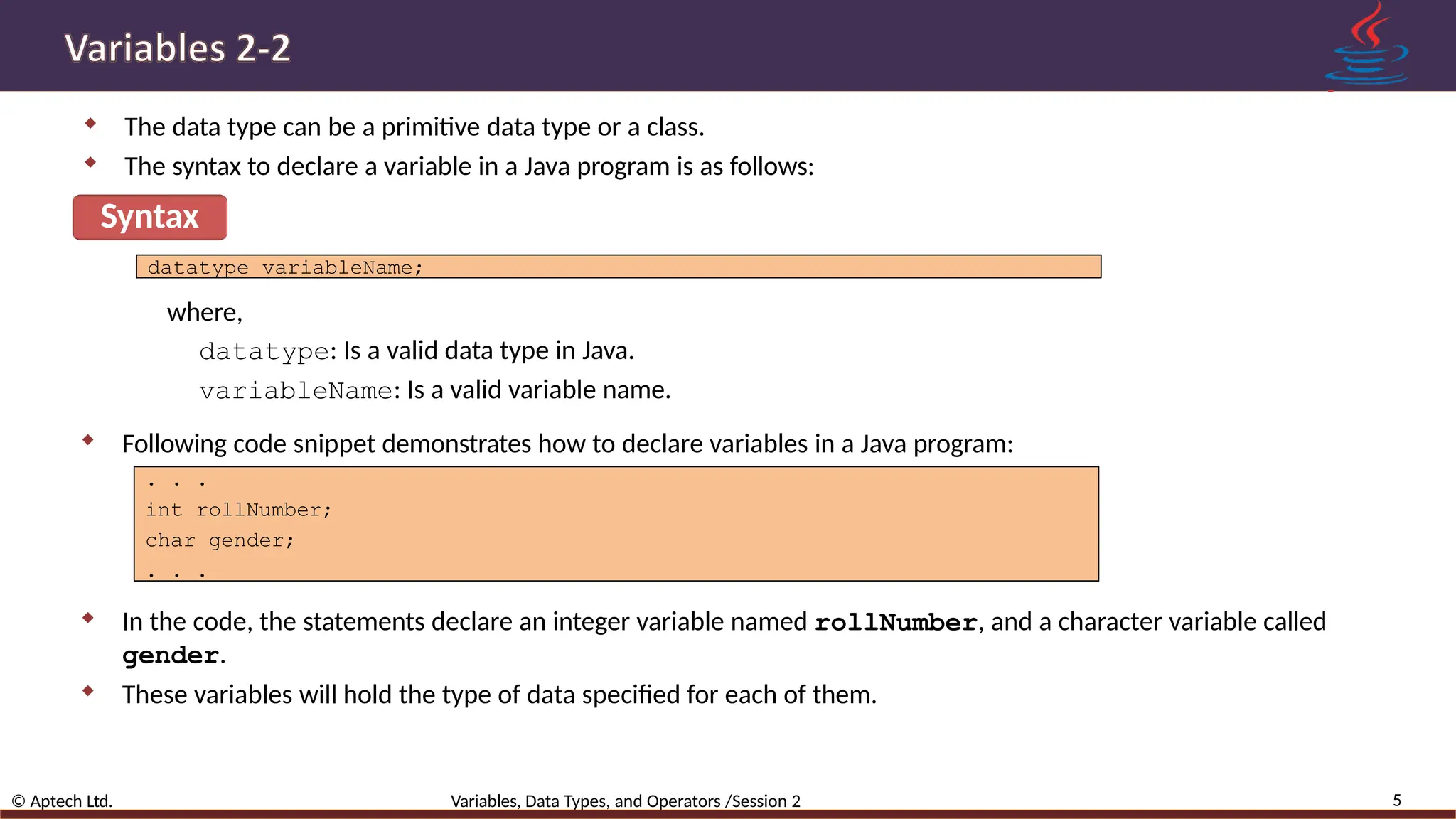
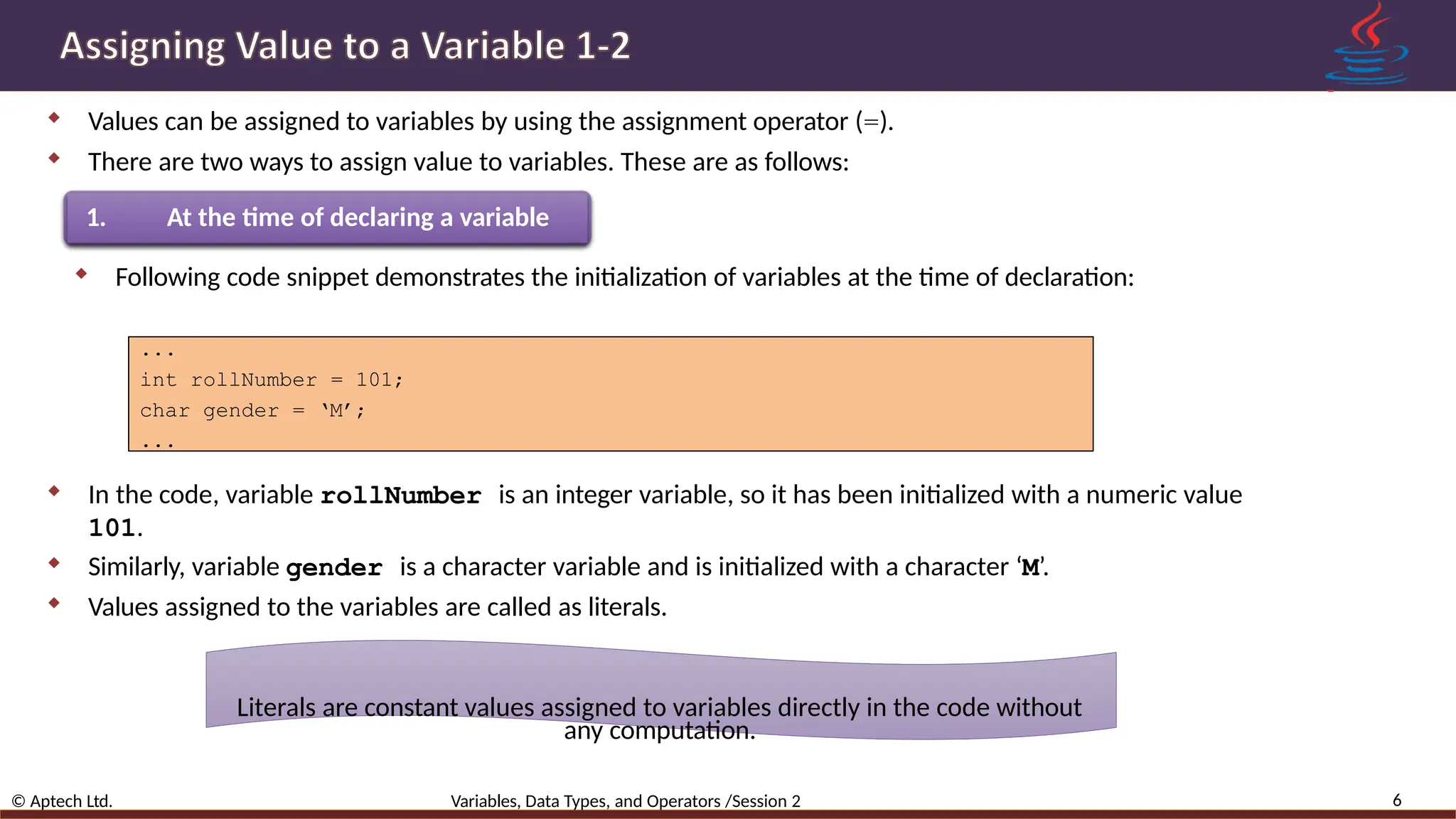
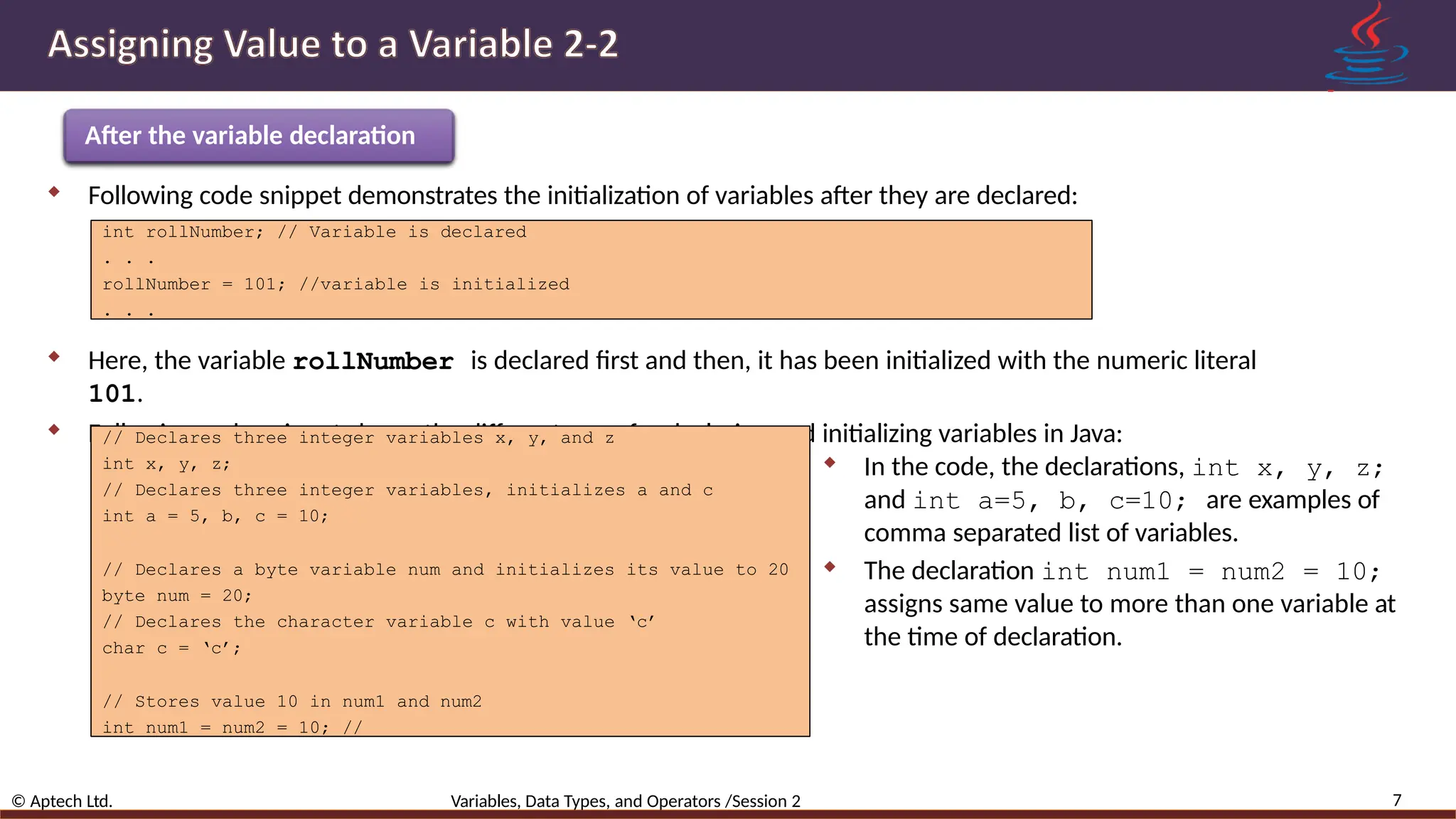
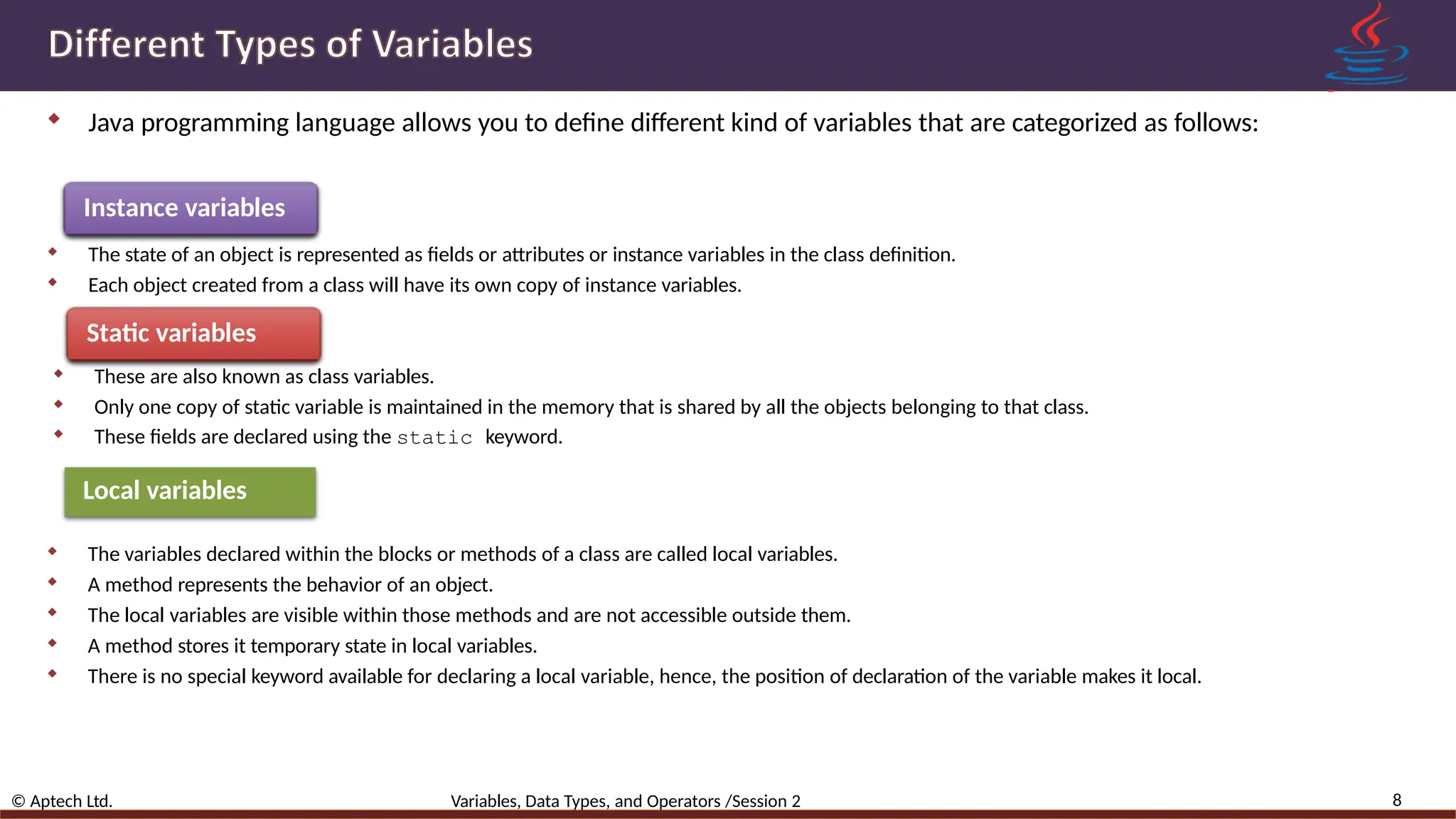
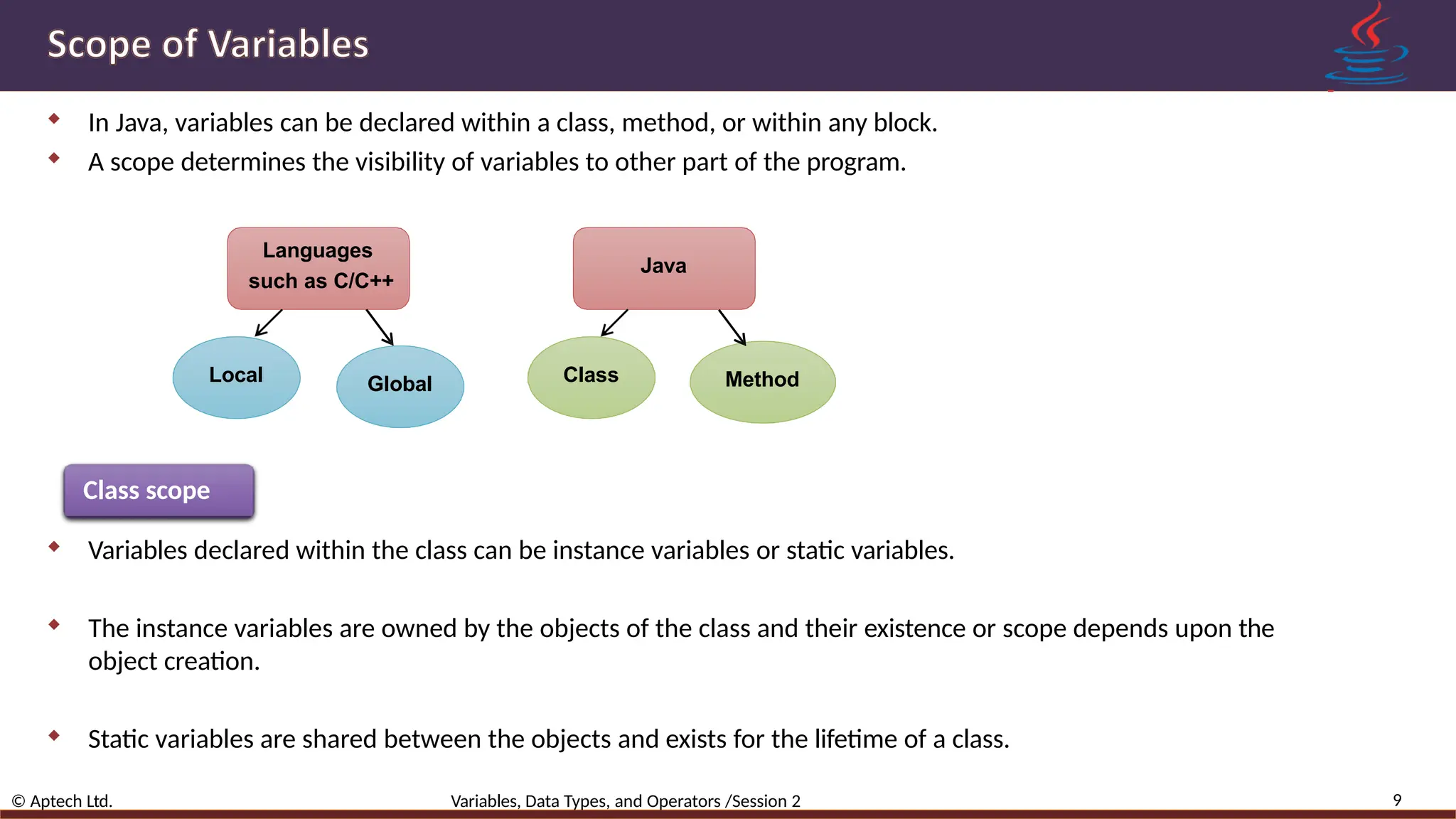
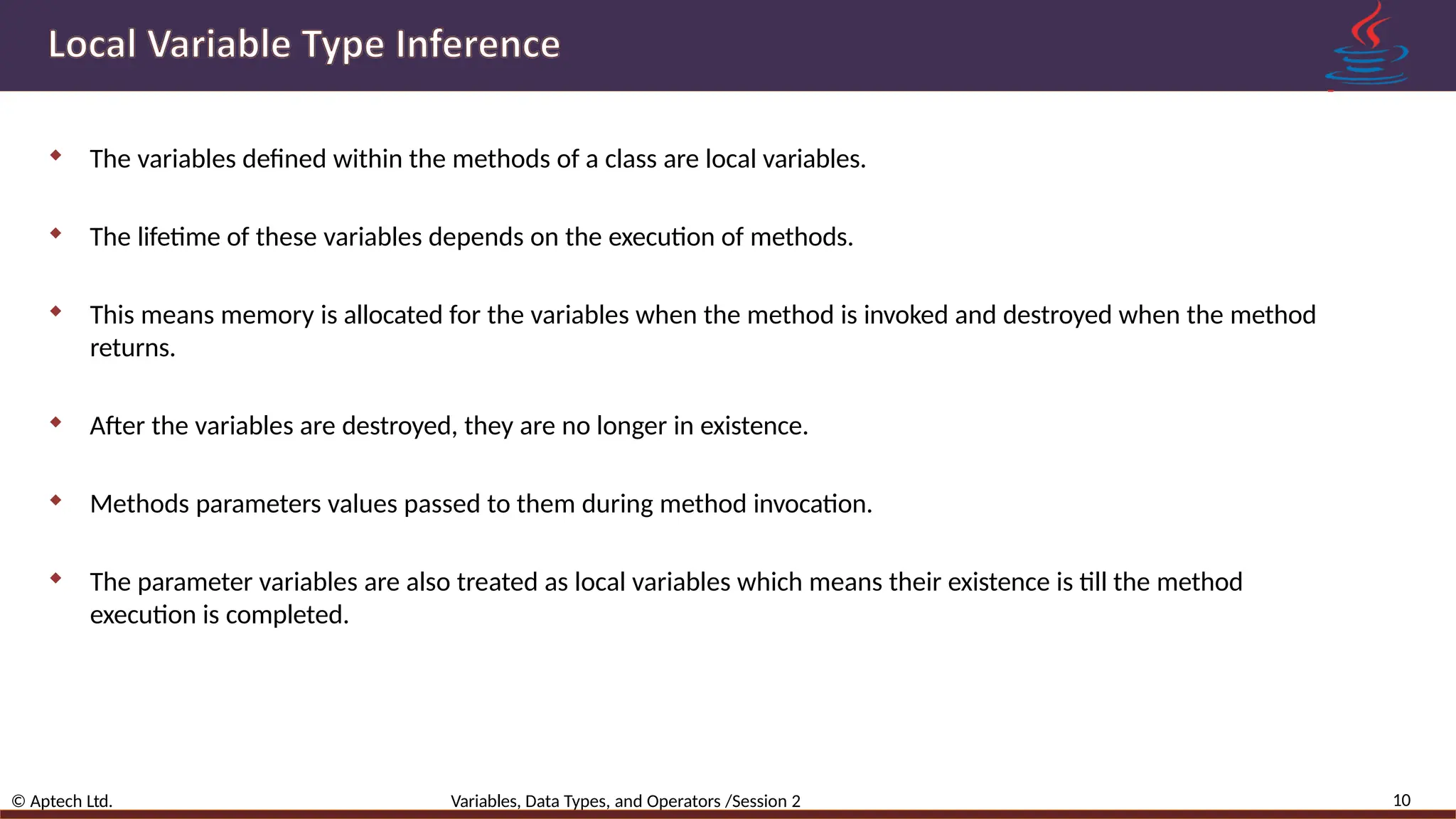
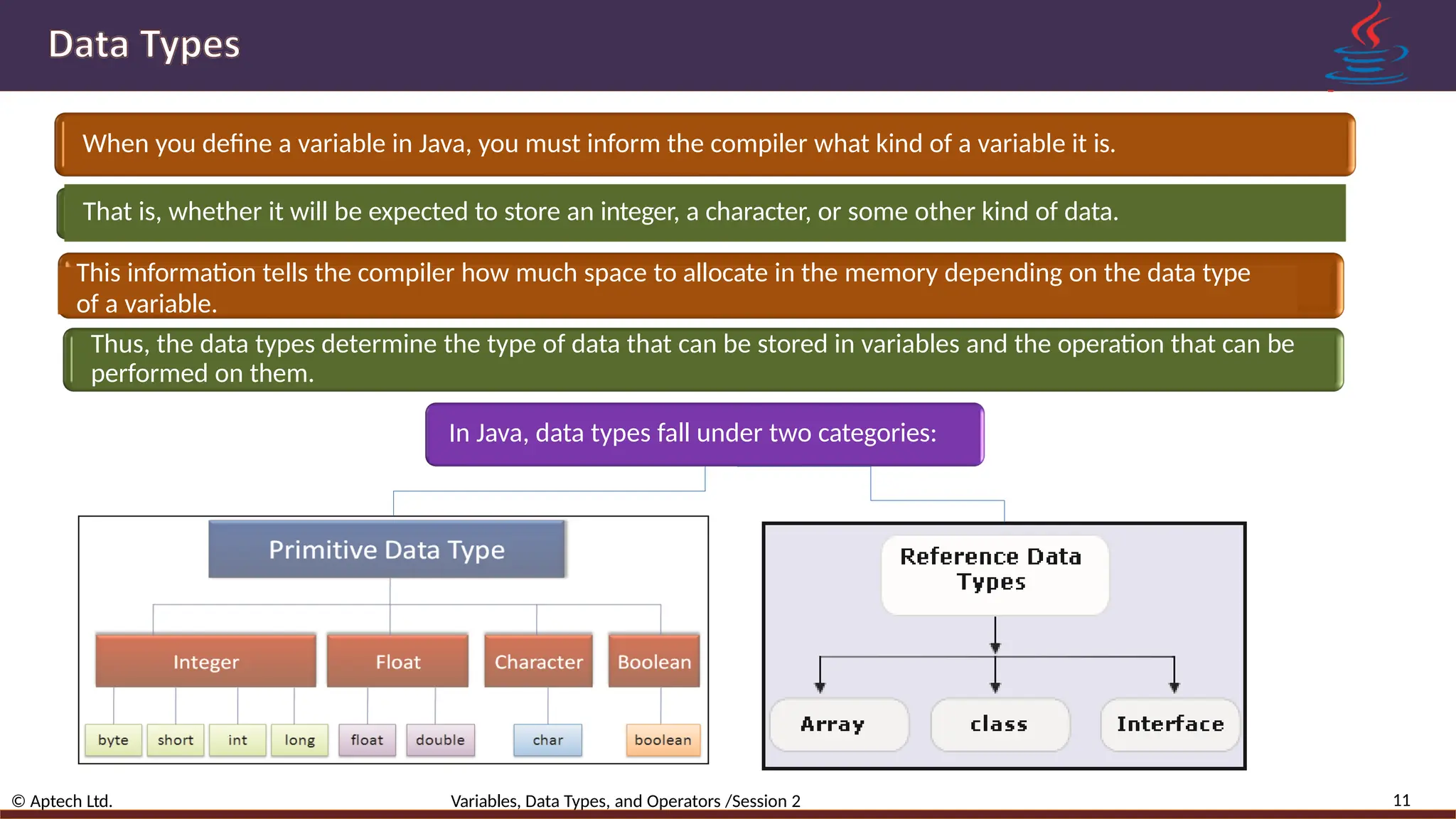
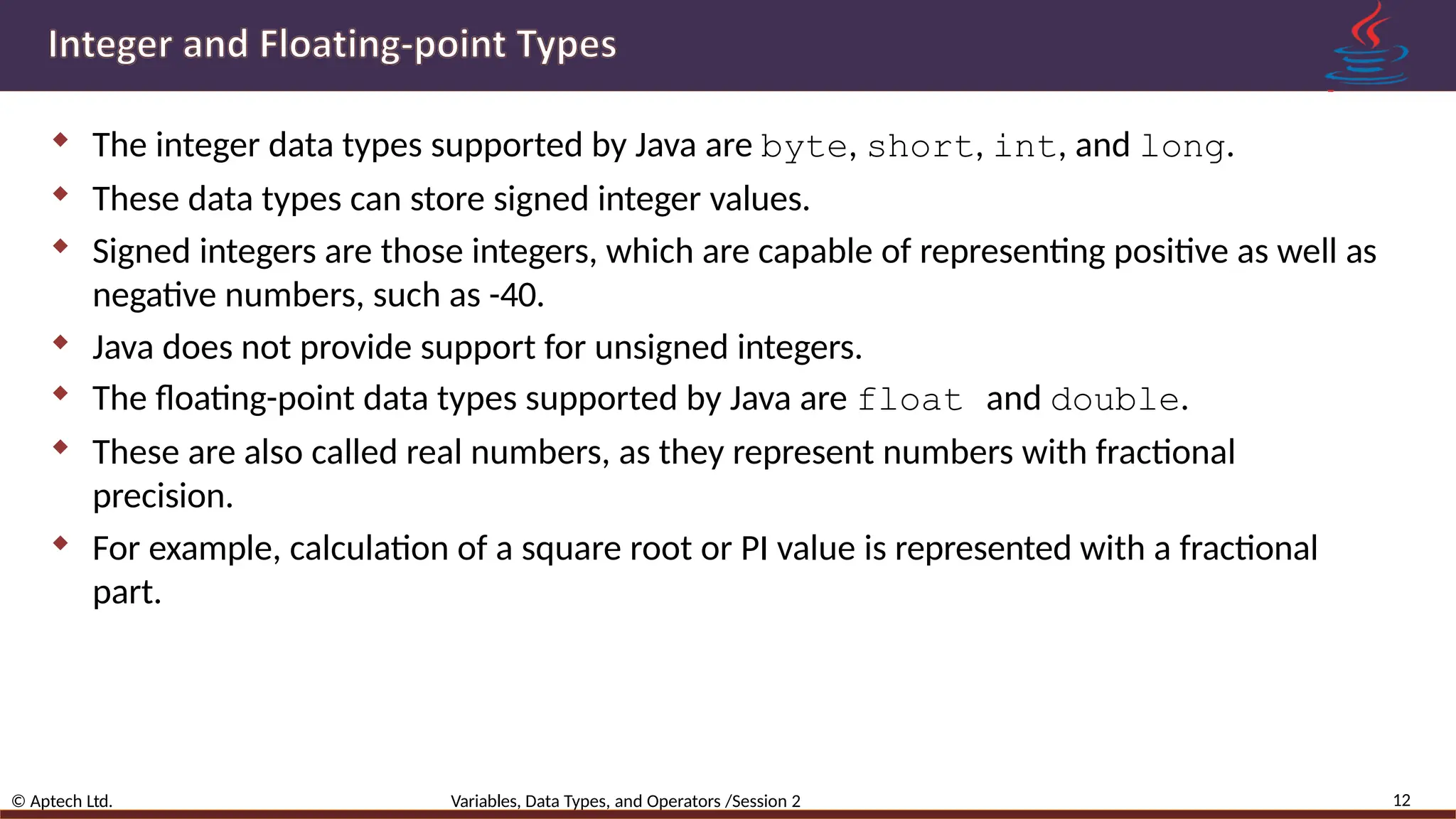
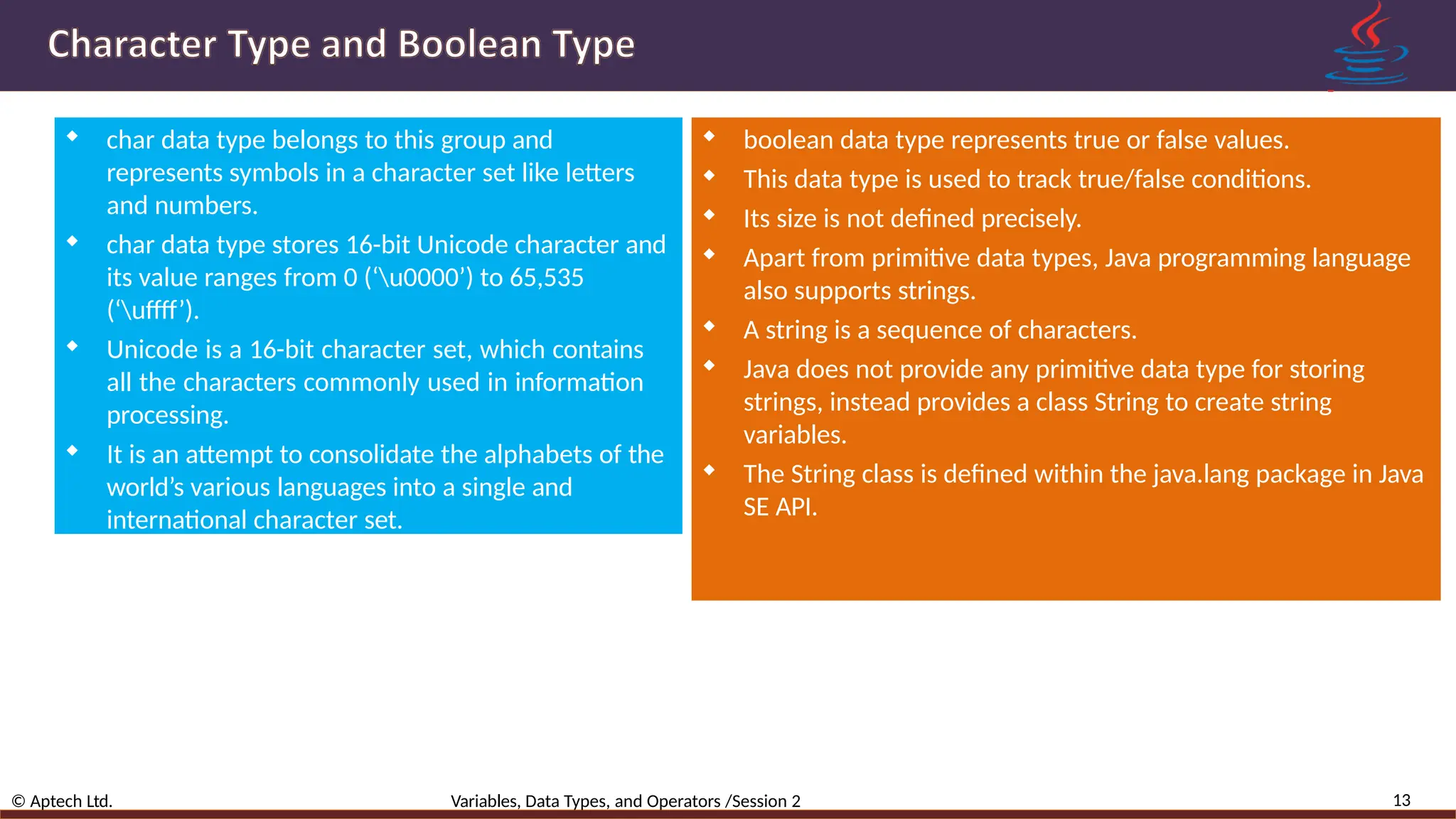
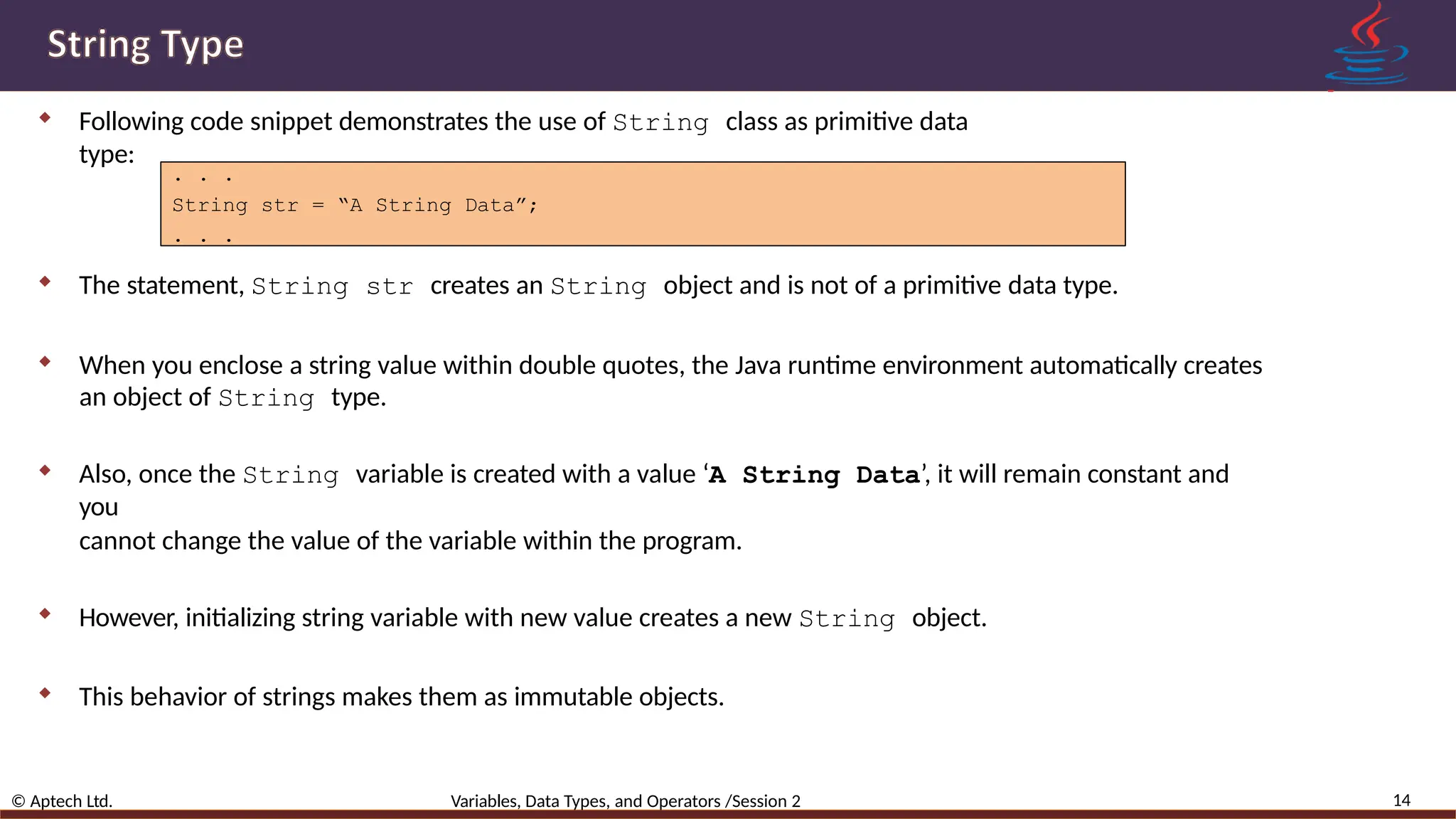
![ Following code snippet demonstrates the use of different data types in Java: public class EmployeeData { /** * @param args the command line arguments */ public static void main(String[] args) { 15 © Aptech Ltd. Variables, Data Types, and Operators /Session 2 // Declares a variable of type integer int empNumber; //Declares a variable of type decimal float salary; // Declare and initialize a decimal variable double shareBalance = 456790.897; // Declare a variable of type character char gender = ‘M’; // Declare and initialize a variable of type boolean boolean ownVehicle = false; // Variables, empNumber and salary are initialized empNumber = 101; salary = 6789.50f; // Prints the value of the variables on the console System.out.println(“Employee Number: “ + empNumber); System.out.println(“Salary: “ + salary); System.out.println(“Gender: “ + gender); System.out.println(“Share Balance: “ + shareBalance); System.out.println(“Owns vehicle: “ + ownVehicle); } }](https://image.slidesharecdn.com/ljfj-session2-250325032834-f5ce623b/75/Learning-Java-2-Variables-Data-Types-and-Operators-15-2048.jpg)
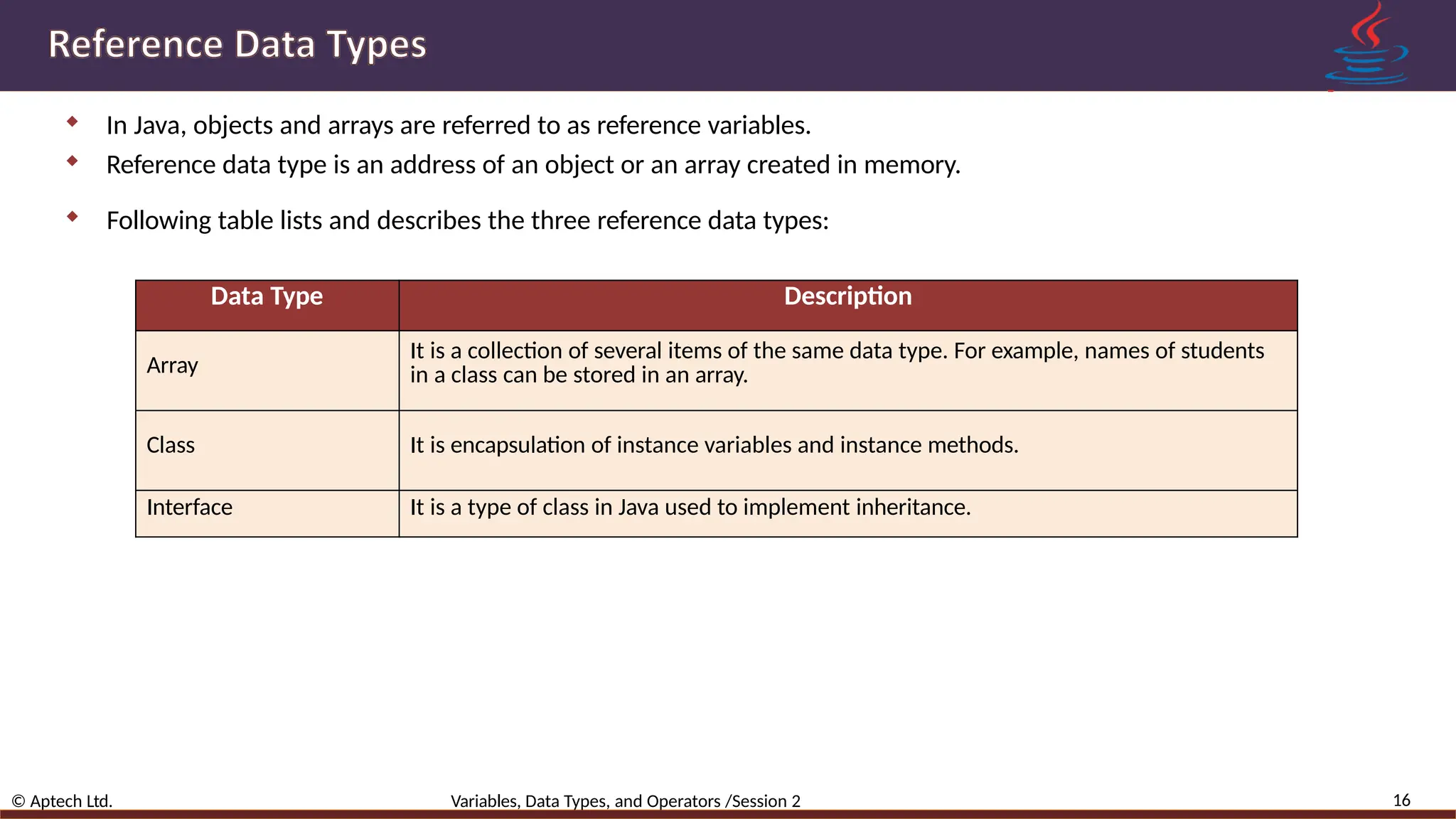
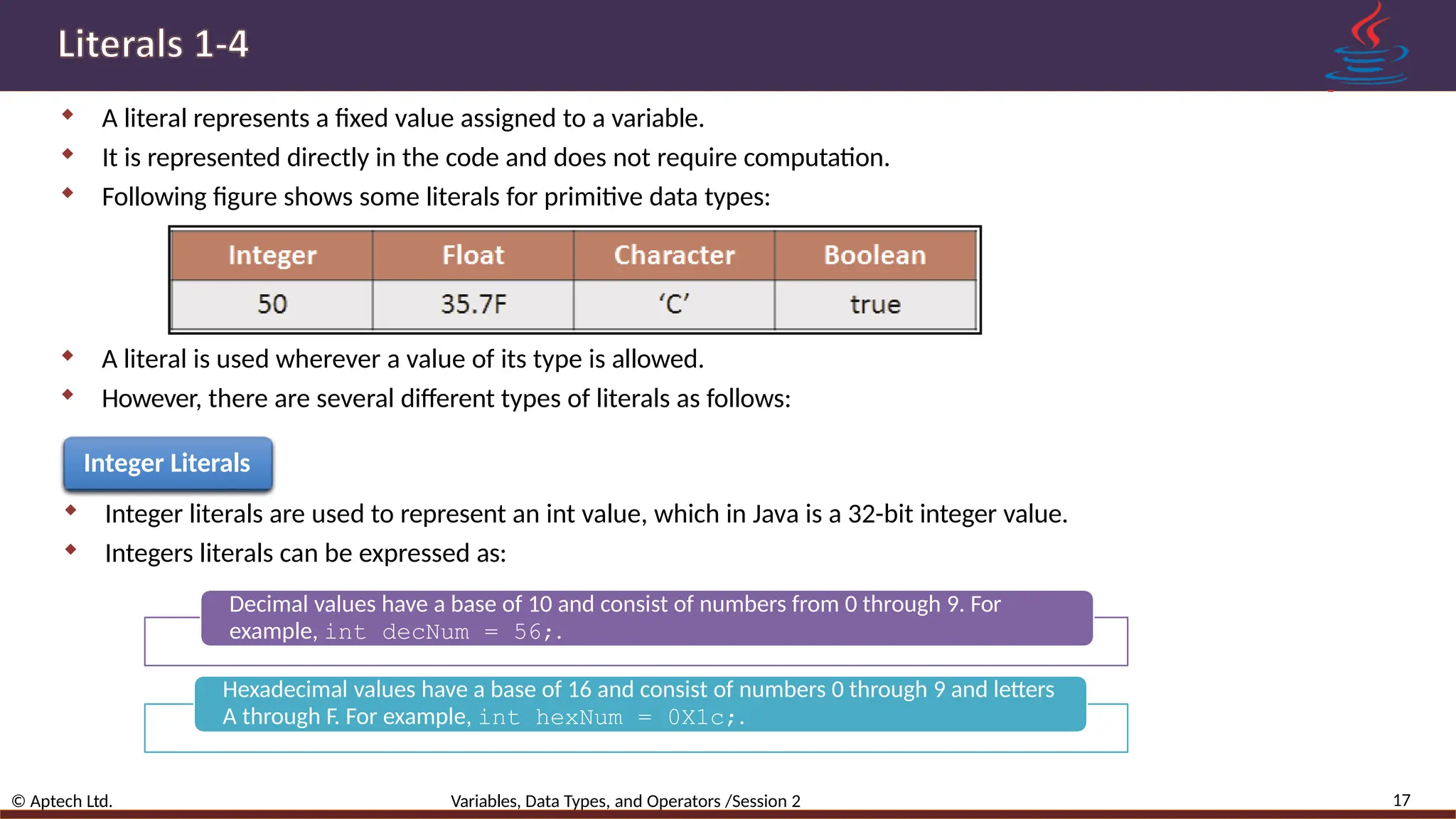
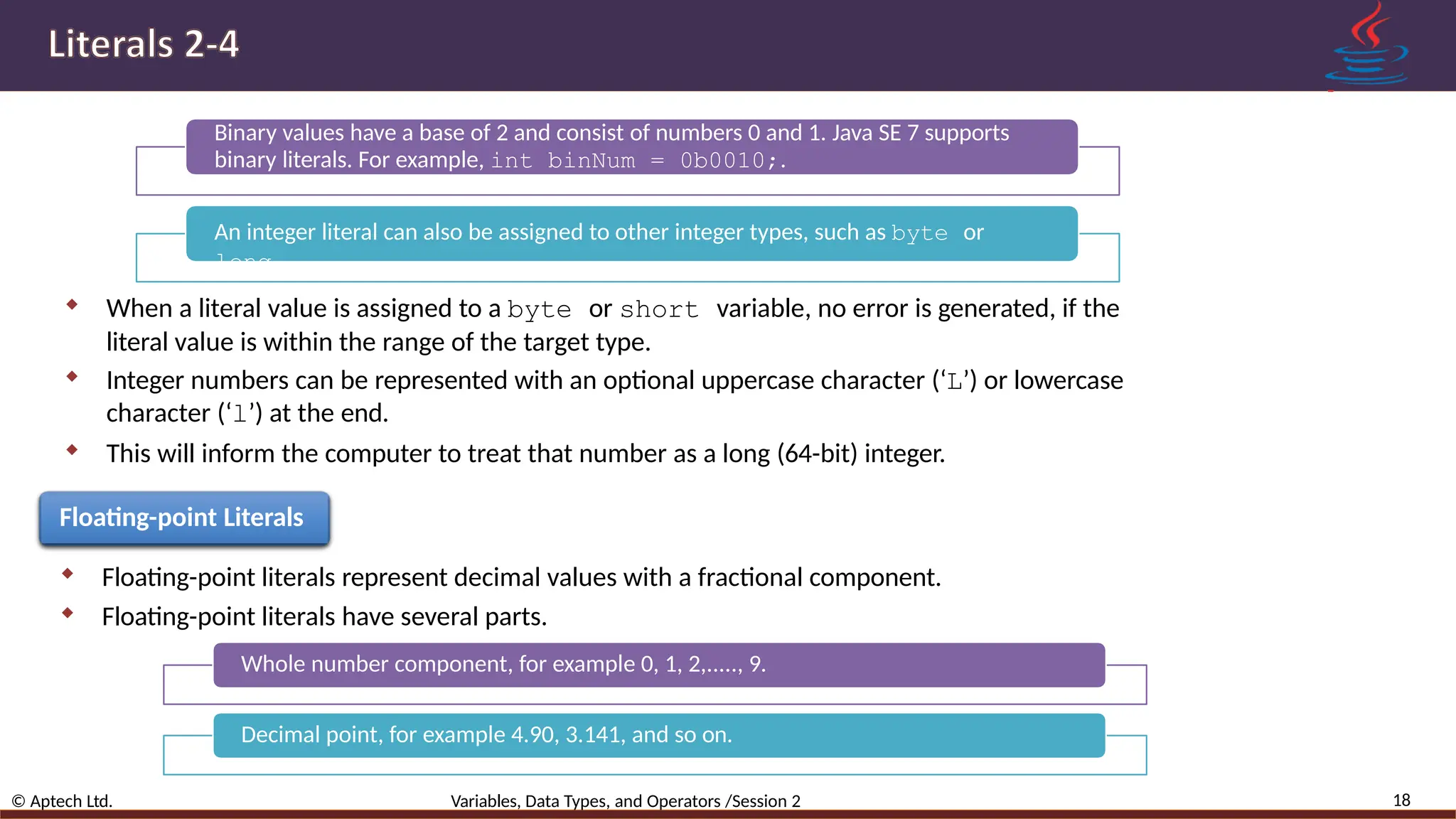
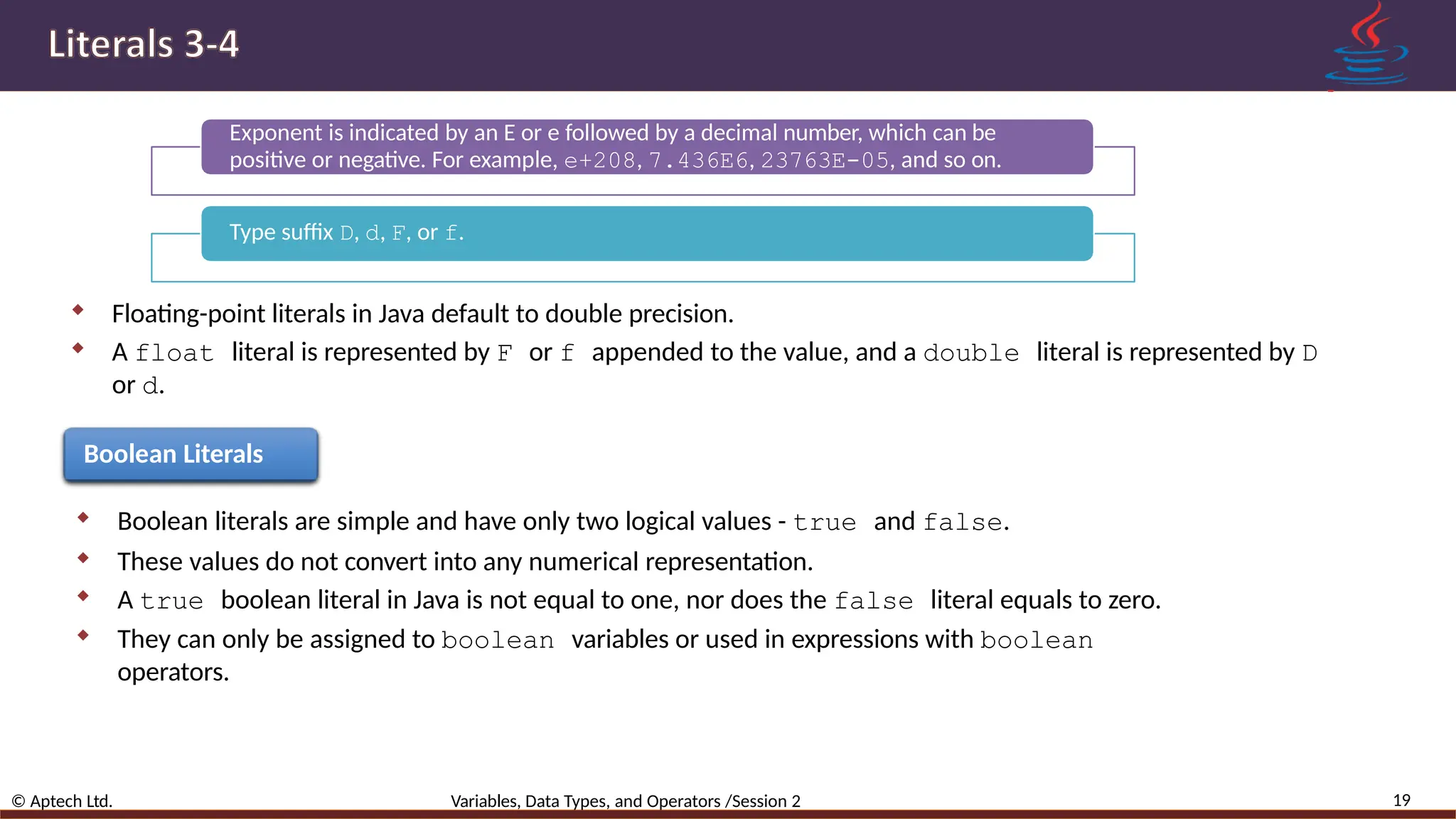
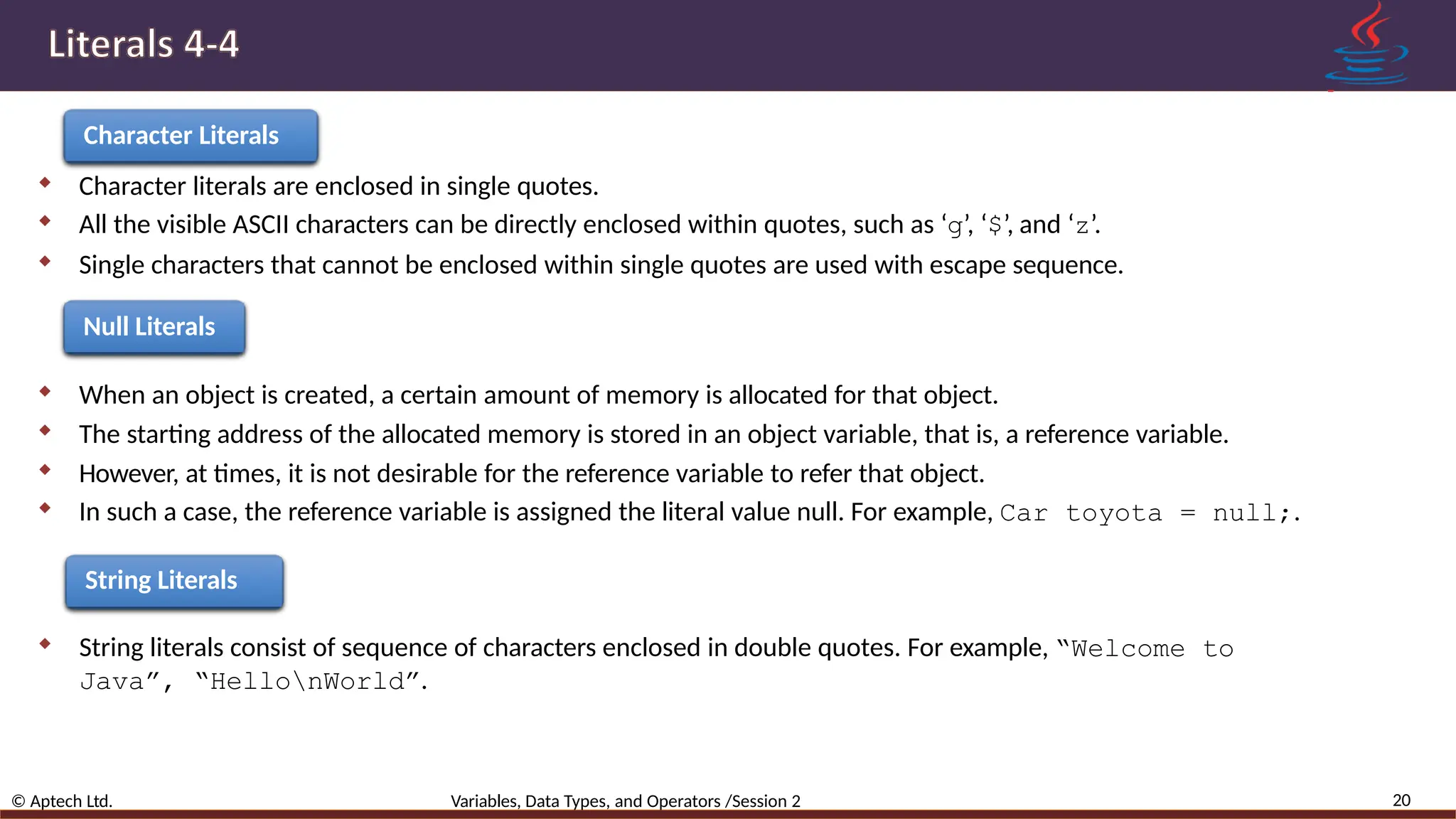
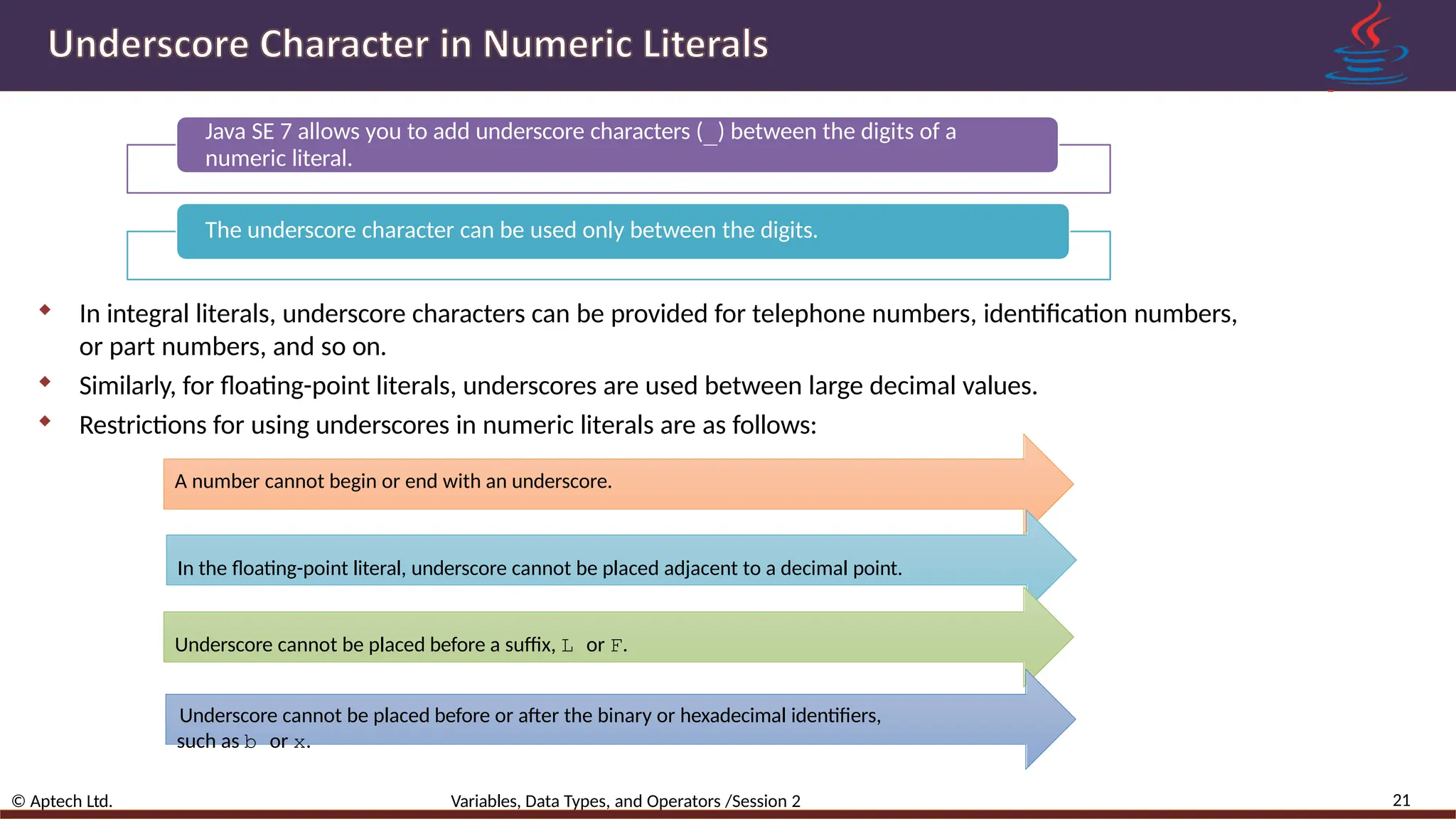
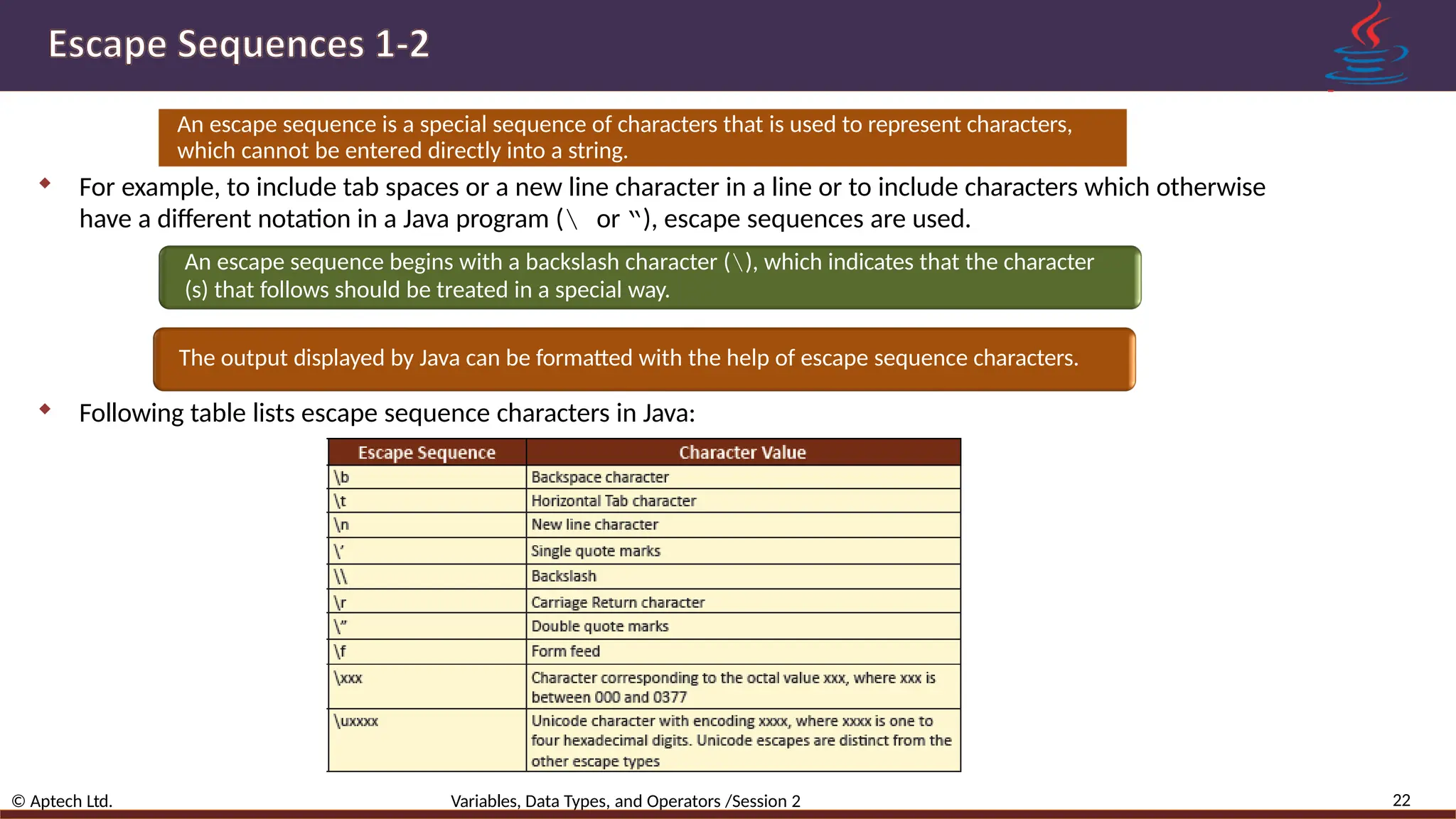
![ Following code snippet demonstrates the use of escape sequence characters: 23 © Aptech Ltd. Variables, Data Types, and Operators /Session 2 public class EscapeSequence { /* * @param args the command line arguments */ public static void main(String[] args) { // Uses tab and new line escape sequences System.out.println(“Java t Programming n Language”); // Prints Tom “Dick” Harry string System.out.println(“Tom ”Dick” Harry”); } } To represent a Unicode character, u escape sequence can be used in a Java program. A Unicode character can be represented using hexadecimal or octal sequences. public class UnicodeSequence { /** * @param args the command line arguments */ public static void main(String[] args) { // Prints ‘Hello’ using hexadecimal escape sequence characters System.out.println(“u0048u0065u006Cu006Cu006F” + “!n”); // Prints ‘Blake’ using octal escape sequence character for ‘a’ System.out.println(“Bl141ke”2007” “); } } Following code snippet demonstrates the Unicode characters in a Java program:](https://image.slidesharecdn.com/ljfj-session2-250325032834-f5ce623b/75/Learning-Java-2-Variables-Data-Types-and-Operators-23-2048.jpg)
![ Constants in Java are fixed values assigned to identifiers that are not modified throughout the execution of the code. In Java, the declaration of constant variables is prefixed with the final keyword. The syntax to initialize a constant variable is as follows: Syntax where, 24 © Aptech Ltd. Variables, Data Types, and Operators /Session 2 final data-type variable-name = value; final: Is a keyword and denotes that the variable is declared as a constant. Following code snippet demonstrates code that declares constant variables: public class AreaOfCircle { /** * @param args the command line arguments */ public static void main(String[] args) { // Declares constant variable final double PI = 3.14159; double radius = 5.87; double area; // Calculates the value for the area variable area = PI * radius * radius; System.out.println(“Area of the circle is: “ + area); } }](https://image.slidesharecdn.com/ljfj-session2-250325032834-f5ce623b/75/Learning-Java-2-Variables-Data-Types-and-Operators-24-2048.jpg)
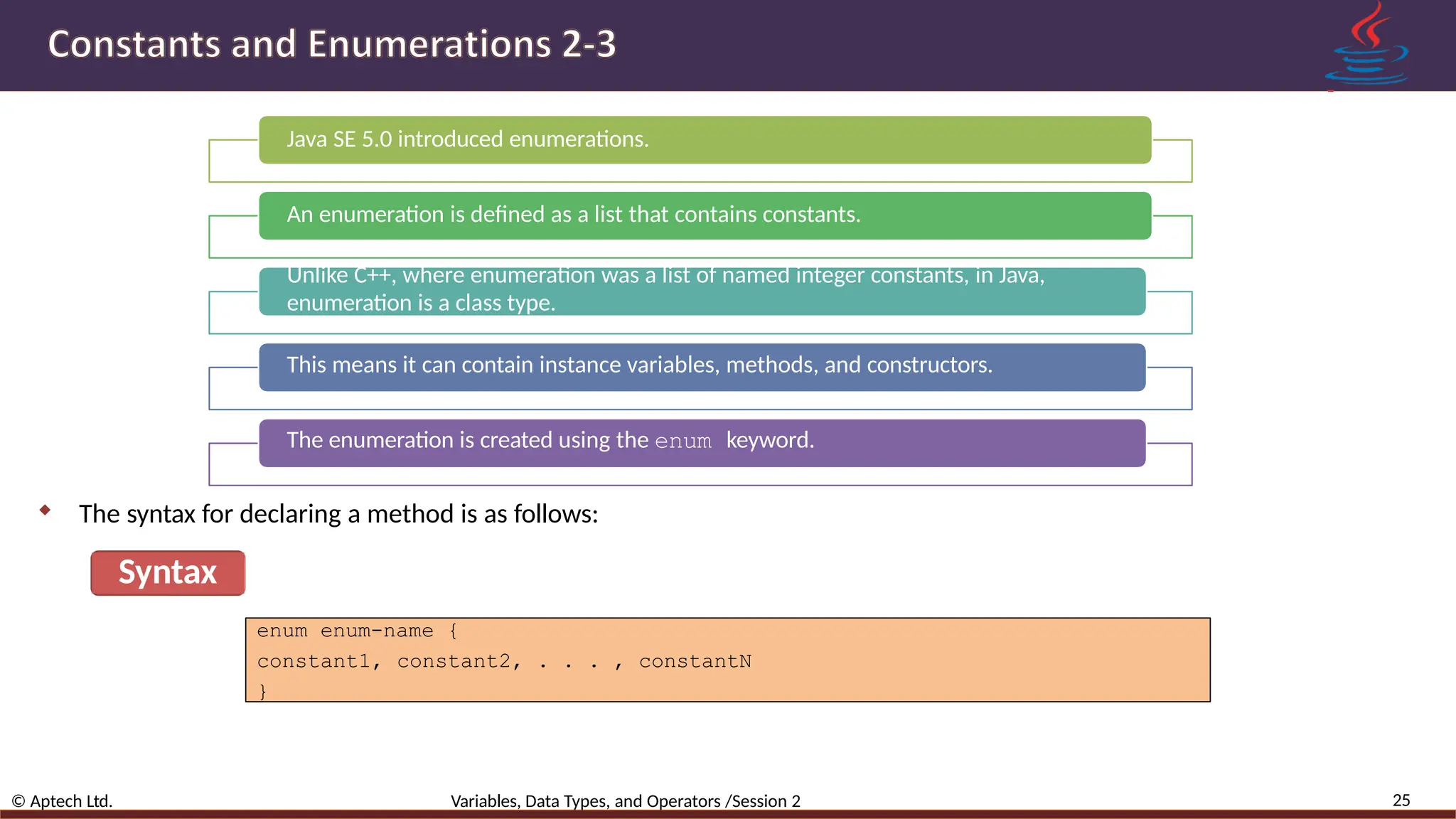
![ Though, enumeration is a class in Java, you do not use new operator to instantiate it. Instead, declare a variable of type enumeration to use it in the Java program. This is similar to using primitive data types. The enumeration is mostly used with decision-making constructs, such as switch-case statement. 26 © Aptech Ltd. Variables, Data Types, and Operators /Session 2 public class EnumDirection { /** * Declares an enumeration */ enum Direction { East, West, North, South } /** * @param args the command line arguments */ public static void main(String[] args) { // Declares a variable of type Direction Direction direction; // Instantiate the enum Direction direction = Direction.East; // Prints the value of enum System.out.println(“Value: “ + direction); } } Following code snippet demonstrates the declaration of enumeration in a Java program:](https://image.slidesharecdn.com/ljfj-session2-250325032834-f5ce623b/75/Learning-Java-2-Variables-Data-Types-and-Operators-26-2048.jpg)
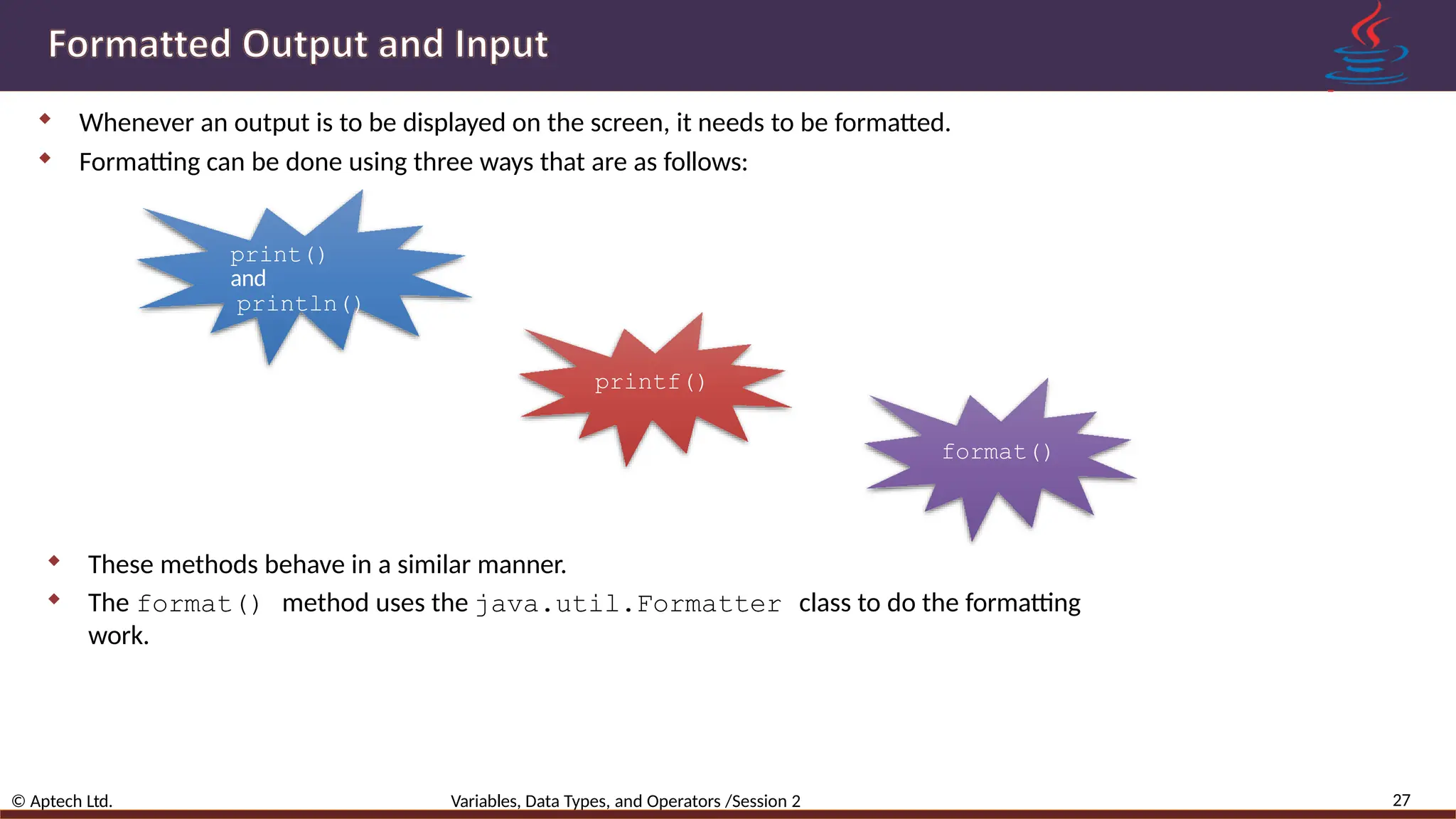
![ These methods convert all the data to strings and display it as a single value. The method uses appropriate toString() method for conversion of the values. These methods can also be used to print mixture combination of strings and numeric values as strings on the standard output. public class DisplaySum { /** * @param args the command line arguments */ public static void main(String[] args) { int num1 = 5; int num2 = 10; int sum = num1 + num2; System.out.print(“The sum of “); System.out.print(num1); System.out.print(“ and “); System.out.print(num2); System.out.print(“ is “); System.out.print(sum); System.out.println(“.”); int num3 = 2; sum = num1 + num2 + num3; System.out.println(“The sum of “ + num1 + “, “ + num2 + “ and “ + num3 + “ is “ + sum + “.”); } } 28 © Aptech Ltd. Variables, Data Types, and Operators /Session 2 Following code snippet demonstrates use of print() and println() methods:](https://image.slidesharecdn.com/ljfj-session2-250325032834-f5ce623b/75/Learning-Java-2-Variables-Data-Types-and-Operators-28-2048.jpg)
![ The printf() method introduced in J2SE 5.0 can be used to format the numerical output to the console. 29 © Aptech Ltd. Variables, Data Types, and Operators /Session 2 Following code snippet demonstrates the use of printf() methods to format the output: public class FormatSpecifier { /** * @param args the command line arguments */ public static void main(String[] args) { int i = 55 / 22; // Decimal integer System.out.printf(“55/22 = %d %n”, i); // Pad with zeros double q = 1.0 / 2.0; System.out.printf(“1.0/2 .0 = %09.3f %n”, q); // Scientific notation q = 5000.0 / 3.0; System.out.printf(“5000/3 .0 = %7.2e %n”, q); // Negative infinity q = -10.0 / 0.0; System.out.printf(“- 10.0/0.0 = %7.2e %n”, q); // Multiple arguments, PI value, E–base of natural logarithm System.out.printf(“pi](https://image.slidesharecdn.com/ljfj-session2-250325032834-f5ce623b/75/Learning-Java-2-Variables-Data-Types-and-Operators-29-2048.jpg)
![ This method formats multiple arguments based on a format string. The format string consists of the normal string literal information associated with format specifiers and an argument list. The syntax of a format specifier is as follows: Syntax %[arg_index$] [flags] [width] [.precision] conversion character where, arg_index: Is an integer followed by a $ symbol. The integer indicates that the argument should be printed in the mentioned position. flags: Is a set of characters that format the output result. There are different flags available in Java. 30 © Aptech Ltd. Variables, Data Types, and Operators /Session 2](https://image.slidesharecdn.com/ljfj-session2-250325032834-f5ce623b/75/Learning-Java-2-Variables-Data-Types-and-Operators-30-2048.jpg)
![ The values within ‘[]’ are optional. The only required elements of format specifier are the % and a conversion character. Following code snippet demonstrates the format() method: 31 © Aptech Ltd. Variables, Data Types, and Operators /Session 2 public class VariableScope { /** * @param args the command line arguments */ public static void main(String[] args) { int num = 2; double result = num * num; System.out.format(“The square root of %d is %f.%n”, num, result); } }](https://image.slidesharecdn.com/ljfj-session2-250325032834-f5ce623b/75/Learning-Java-2-Variables-Data-Types-and-Operators-31-2048.jpg)
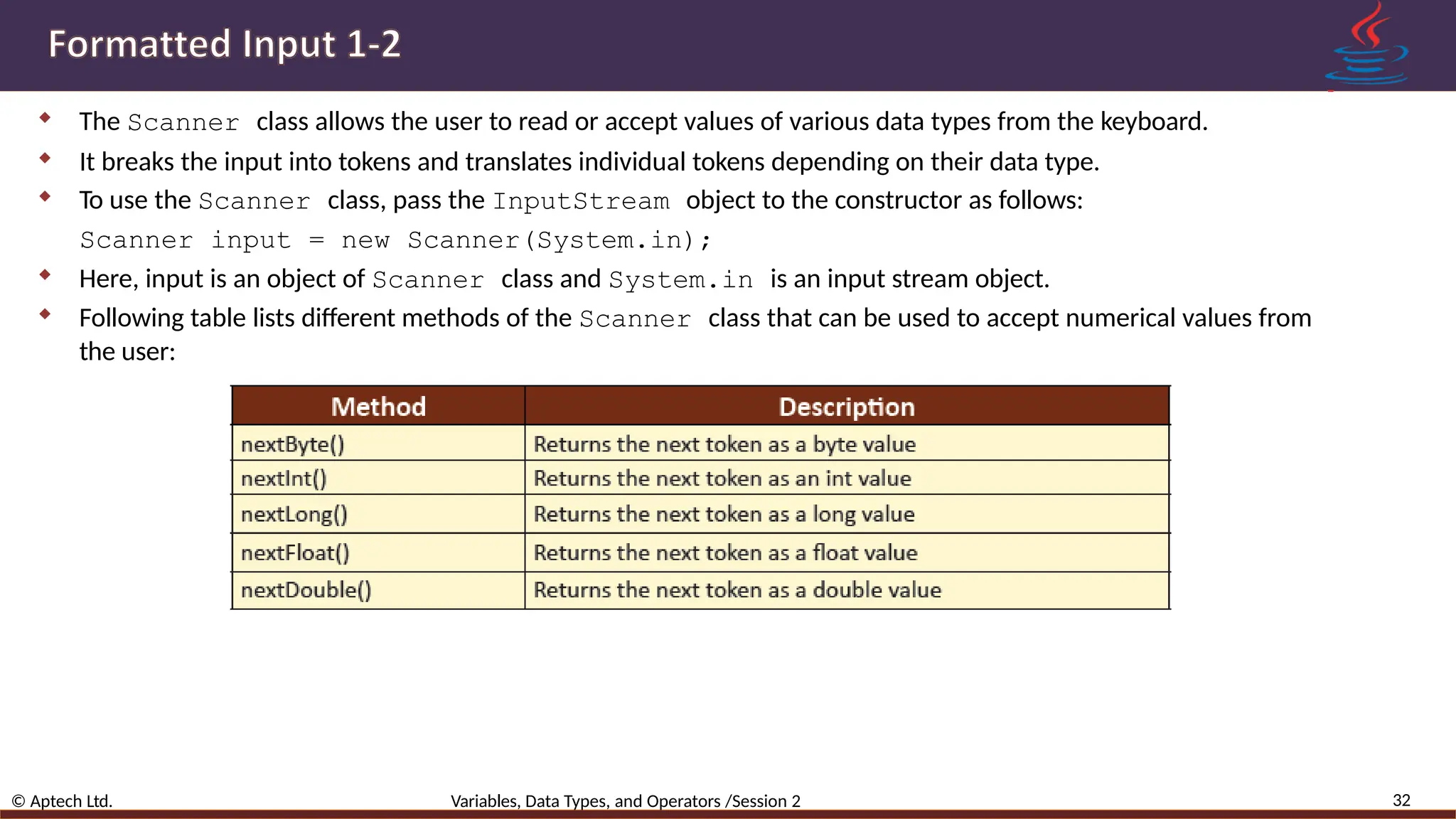
![ Following code snippet demonstrates the Scanner class methods and how they can be used to accept values from the user: 33 © Aptech Ltd. Variables, Data Types, and Operators /Session 2 public class FormattedInput { /** * @param args the command line arguments */ public static void main(String[] args) { // Creates an object and passes the inputstream object Scanner s = new Scanner(System.in); System.out.println(“Enter a number:”); // Accepts integer value from the user int intValue = s.nextInt(); System.out.println(“Enter a decimal number:”); // Accepts integer value from the user float floatValue = s.nextFloat(); System.out.println(“Enter a String value”); // Accepts String value from the user String strValue = s.next(); System.out.println(“Values entered are: “); System.out.println(intValue + “ “ + floatValue + “ “ + strValue); } }](https://image.slidesharecdn.com/ljfj-session2-250325032834-f5ce623b/75/Learning-Java-2-Variables-Data-Types-and-Operators-33-2048.jpg)
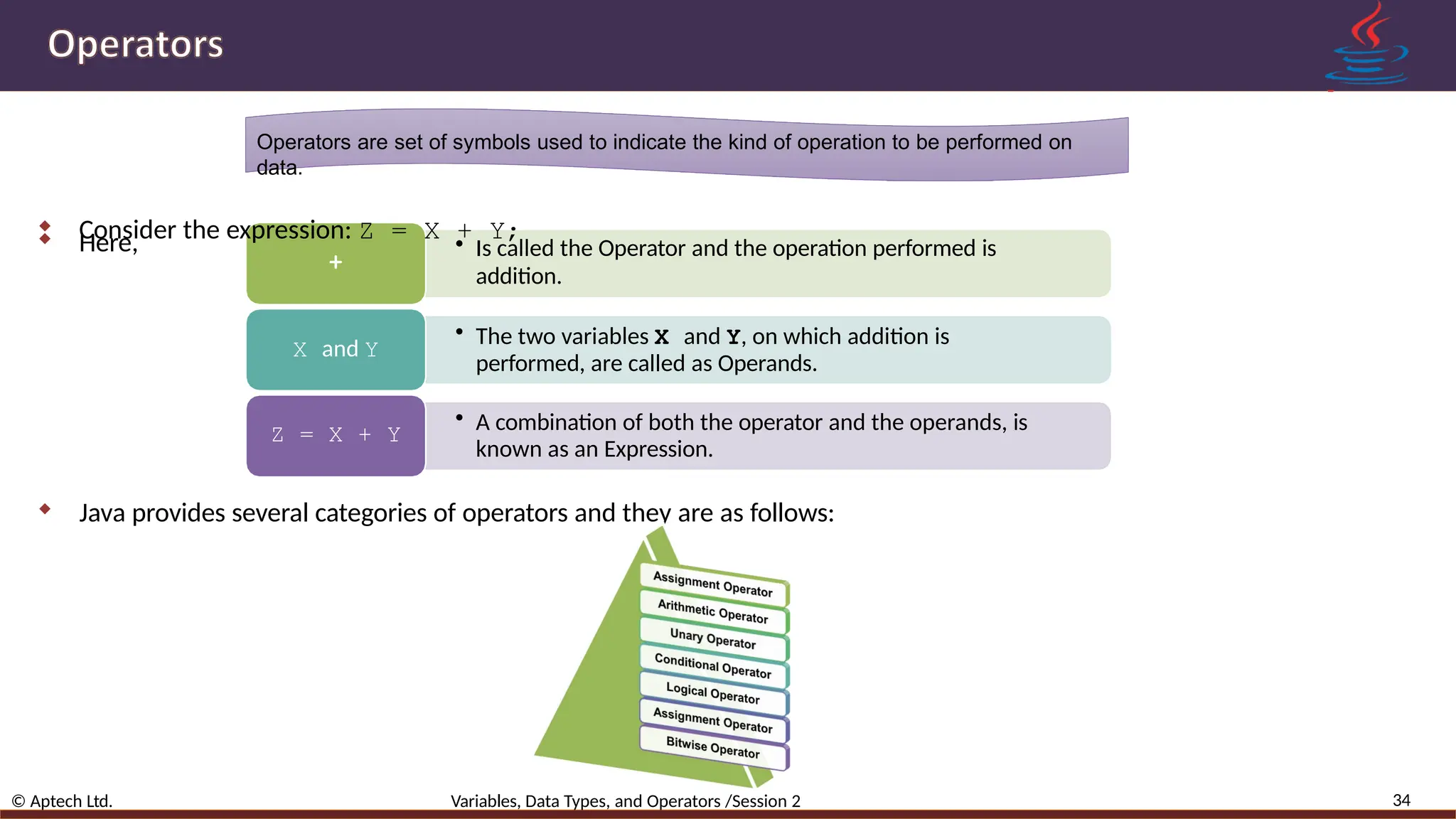
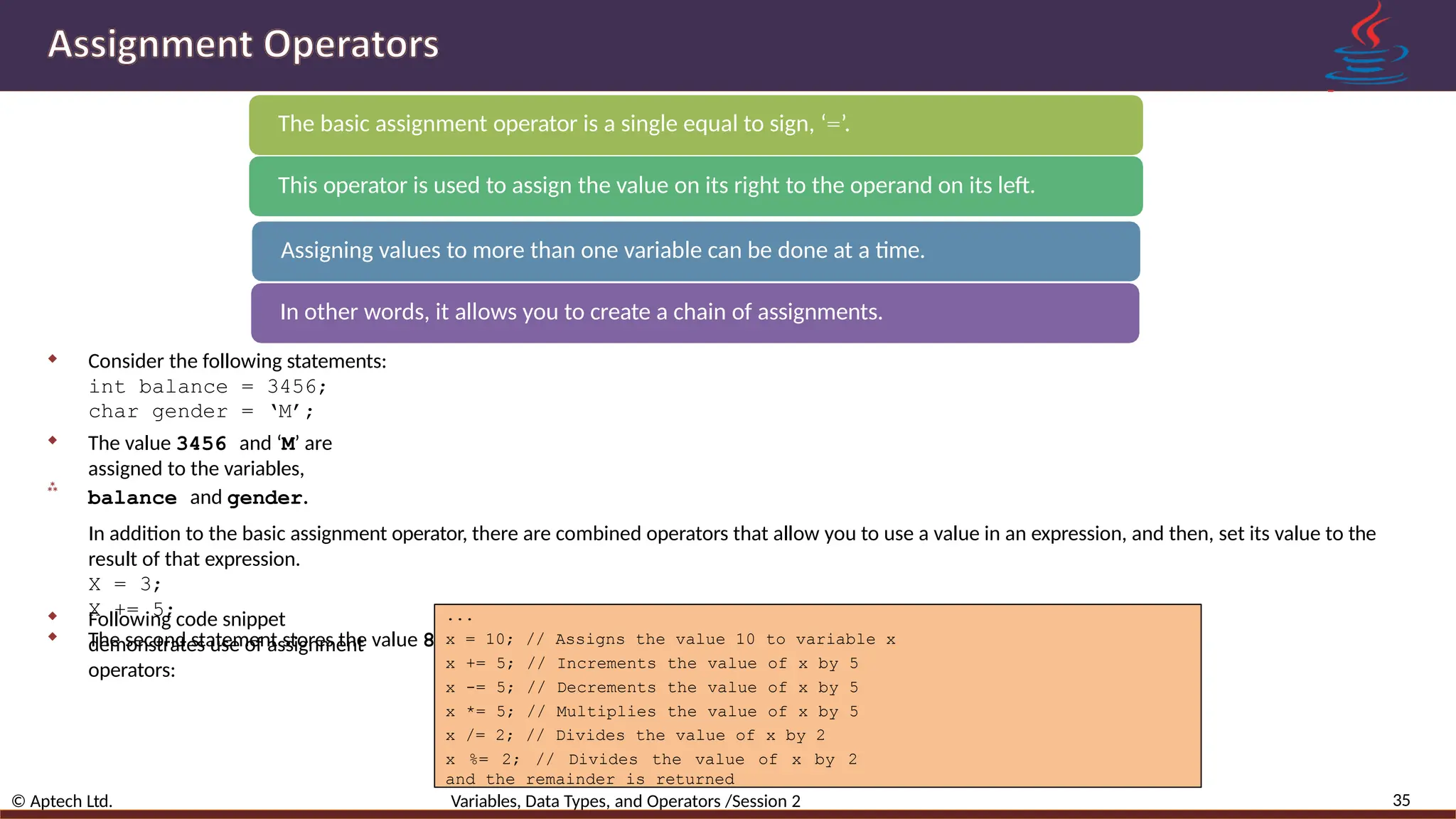
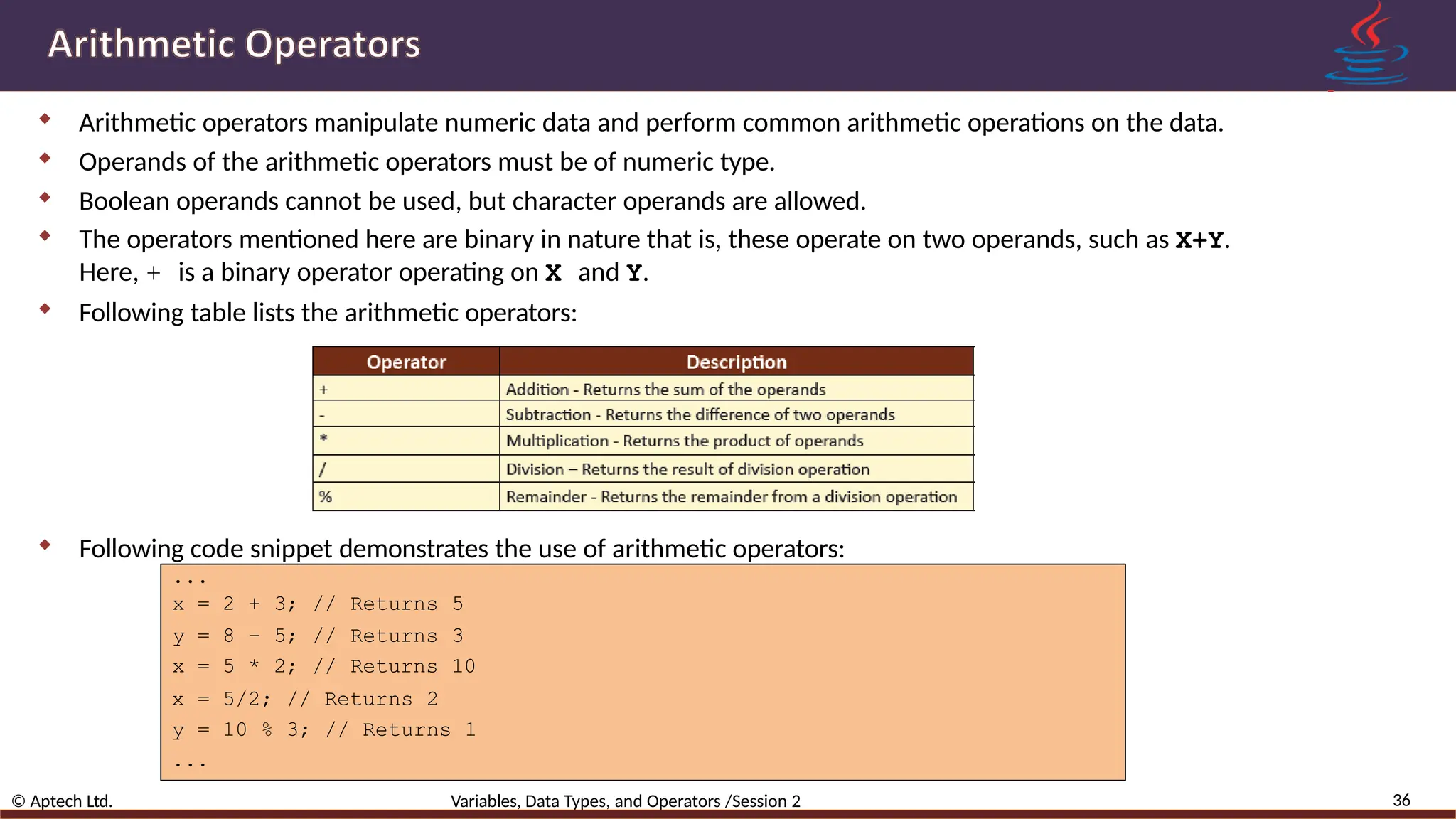
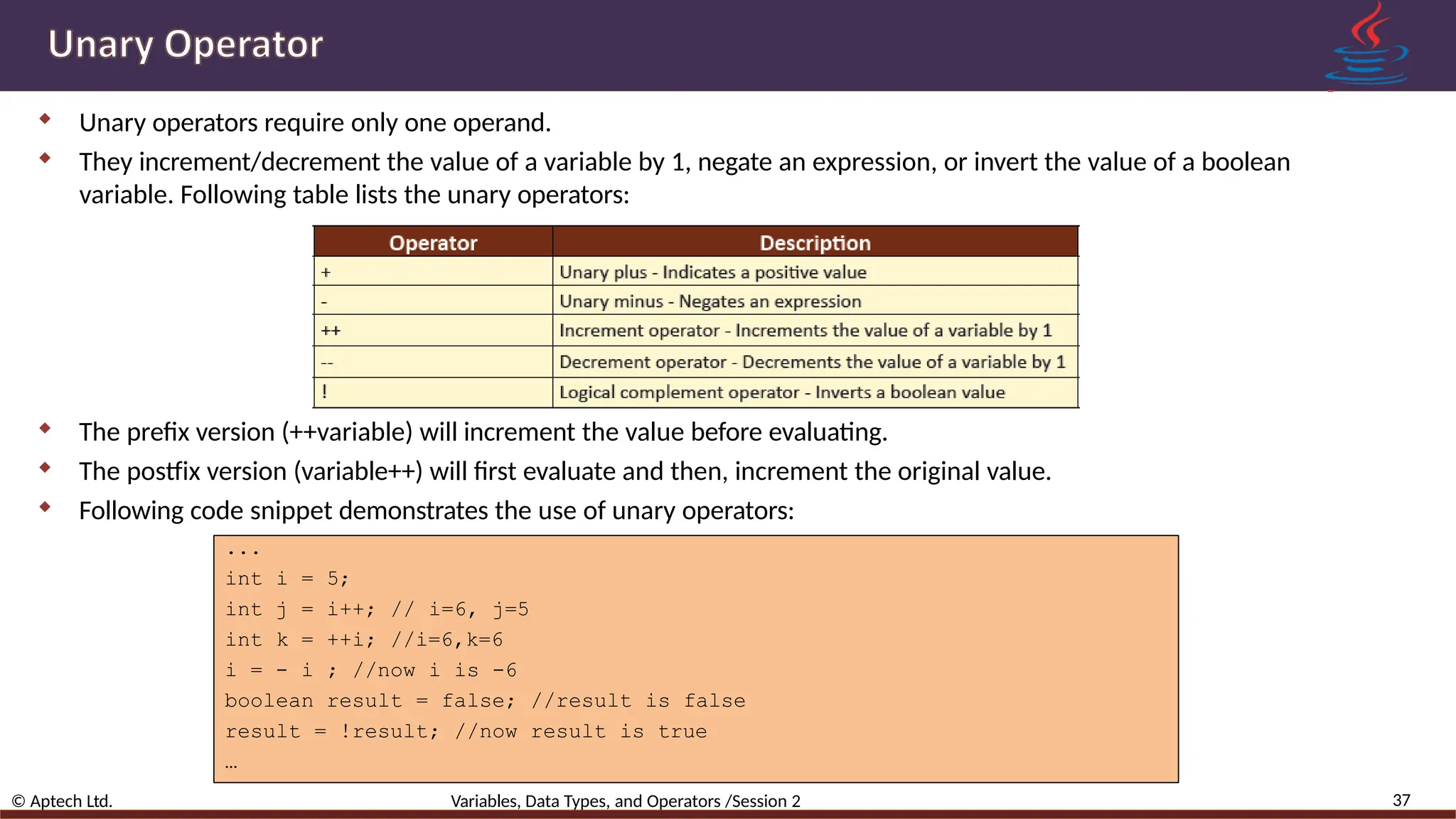
![ The conditional operators test the relationship between two operands. An expression involving conditional operators always evaluates to a boolean value (that is, either true or false). 38 © Aptech Ltd. Variables, Data Types, and Operators /Session 2 Following code snippet demonstrates use of conditional operators: public class TestConditionalOperators { /** * @param args the command line arguments */ public static void main(String[] args) { int value1 = 10; int value2 = 20; // Use of conditional operators System.out.print(“value1 == value2: “); System.out.println(value1 == value2); System.out.print(“value1 != value2: “); System.out.println(value1 != value2); System.out.print(“value1 > value 2: “); System.out.println(value1 > value2); System.out.print(“value1 < value2: “); System.out.println(value1 < value2); System.out.print(“value1 <= value2: “); System.out.println(value1 <= value2); } }](https://image.slidesharecdn.com/ljfj-session2-250325032834-f5ce623b/75/Learning-Java-2-Variables-Data-Types-and-Operators-38-2048.jpg)
![ Logical operators (&& and ||) work on two boolean expressions. These operators exhibit short-circuit behavior, which means that the second operand is evaluated only if required. Following code snippet demonstrates the use of logical operators: 39 © Aptech Ltd. Variables, Data Types, and Operators /Session 2 public class TestLogicalOperators { /** * @param args the command line arguments */ public static void main(String[] args) { int first = 10; int second = 20; // Use of logical operator System.out.println((first == 30) && (second == 20)); System.out.println((first == 30) || (second == 20)); } }](https://image.slidesharecdn.com/ljfj-session2-250325032834-f5ce623b/75/Learning-Java-2-Variables-Data-Types-and-Operators-39-2048.jpg)
![ Bitwise operators work on binary representations of data. These operators are used to change individual bits in an operand. Following code snippet demonstrates the use of bitwise operators: 40 © Aptech Ltd. Variables, Data Types, and Operators /Session 2 public class TestBitwiseOperators { /** * @param args the command line arguments */ public static void main(String[] args) { int x = 23; int y = 12; //23 = 10111 , 12 = 01100 System.out.print(“x & y: “); System.out.println(x & y); // Returns 4 , i.e, 4 = 00100 System.out.print(“x | y: “); System.out.println(x | y); // Returns 31, i.e 31 = 11111 System.out.print(“x ^ y: “); System.out.println(x ^ y); // Returns 27, i.e 31 = 11011 int a = 43; int b = 1; System.out.print(“a >> b: “); System.out.println(a >> b); // returns 21 , i.e, 21 = 0010101 System.out.print(“a << b: “); System.out.println(a << b); //returns 86 , i.e, 86 = 1010110](https://image.slidesharecdn.com/ljfj-session2-250325032834-f5ce623b/75/Learning-Java-2-Variables-Data-Types-and-Operators-40-2048.jpg)
![ The ternary operator (?:) is a shorthand operator for an if-else statement. It makes your code compact and more readable. The syntax to use the ternary operator is as follows: Syntax 41 © Aptech Ltd. Variables, Data Types, and Operators /Session 2 expression1 ? expression2 : expression3 Following code snippet demonstrates the use of ternary operator: public class VariableScope { /** * @param args the command line arguments */ public static void main(String[] args) { int value1 = 10; int value2 = 20; int result; boolean someCondition = true; result = someCondition ? value1 : value2; System.out.println(result); } }](https://image.slidesharecdn.com/ljfj-session2-250325032834-f5ce623b/75/Learning-Java-2-Variables-Data-Types-and-Operators-41-2048.jpg)
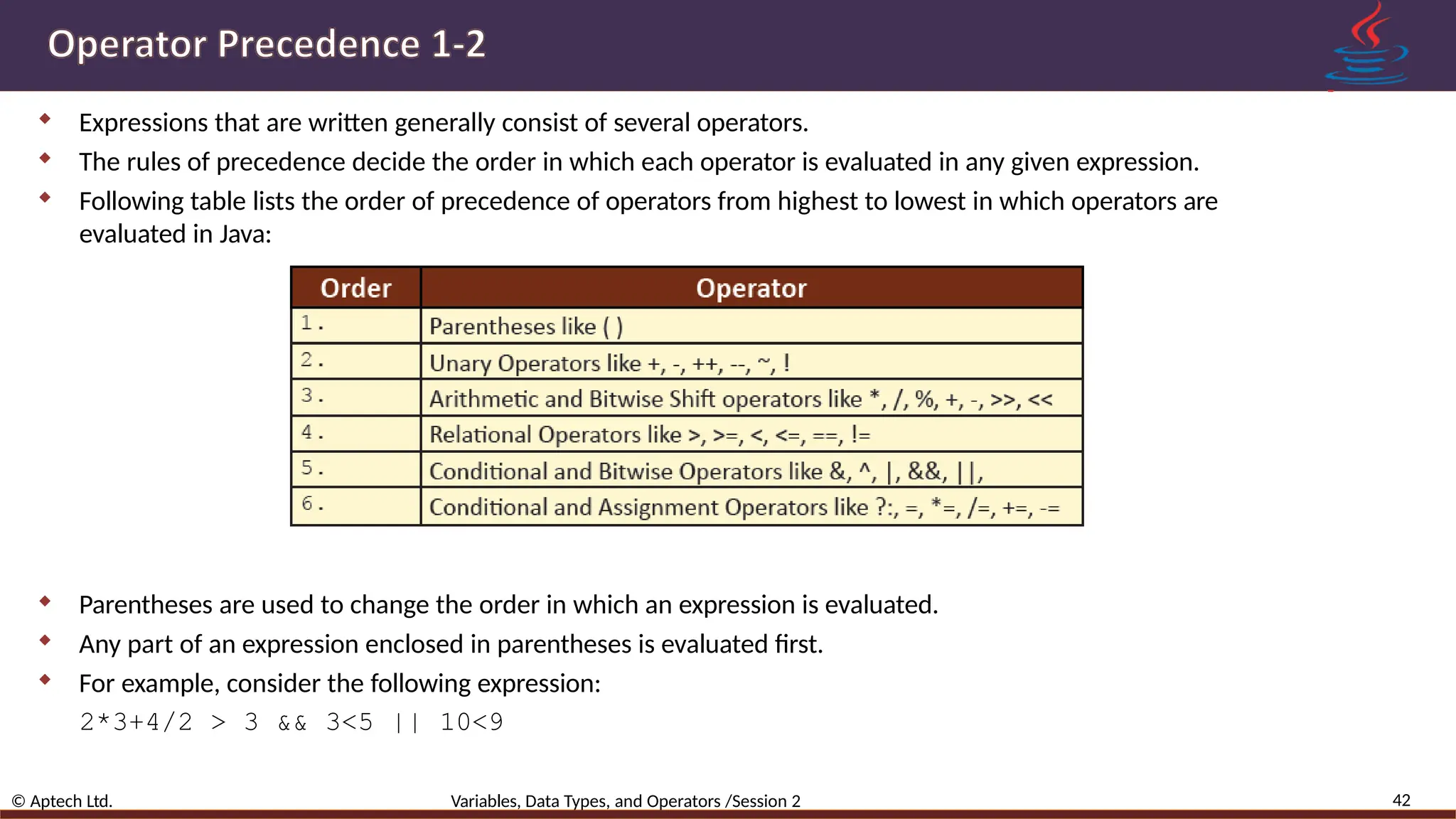
![ The evaluation of the expression based on its operators precedence is as follows: 1 • (2*3+4/2) > 3 && 3<5 || 10<9 • First the arithmetic operators are evaluated. 2 • ((2*3)+(4/2)) > 3 && 3<5 || 10<9 • Division and Multiplication are evaluated before addition and subtraction. 3 • (6+2) >3 && 3<5 || 10<9 4 • (8>3) && [3<5] || [10<9] • Next to be evaluated are the relational operators all of which have the same precedence. 5 • These are therefore evaluated from left to right. • (True && True) || False 6 • The last to be evaluated are the logical operators. && takes precedence over ||. • True || False 7 • True 43 © Aptech Ltd. Variables, Data Types, and Operators /Session 2](https://image.slidesharecdn.com/ljfj-session2-250325032834-f5ce623b/75/Learning-Java-2-Variables-Data-Types-and-Operators-43-2048.jpg)
